Flood-hit dealers could face issues with claims
An industry organisation is warning dealers and consumers may lose out when replacing vehicles written off after extreme weather events unless action is taken by insurance companies around how they define car values.

The Imported Motor Vehicle Industry Association (VIA) is airing concerns that the government’s clean-car programme means the sticker prices of vehicles are no longer the values they should be insured for because penalties or
rebates affect their overall cost.
The problem has come to the fore with about 10,000 cars expected to be scrapped following floods across the Auckland region in late January and Cyclone Gabrielle lashing large swathes of the North Island last month.
VIA says the replacement values of those vehicles may be distorted by the clean car discount (CCD) and clean car standard (CCS).
For example, a vehicle with high emissions will normally result in the buyer paying the asking price and a




CCD penalty. This means replacing it like-for-like will be the combined cost of those sums.
VIA also cautions that as CCS targets shift over coming years –and with them, cost implications –there will be further impacts on the price of replacing vehicles with the same models.
It is now raising awareness of the issue with members, as well as with Waka Kotahi NZ Transport Agency, the Insurance Council of NZ and insurance companies.
David Vinsen, VIA’s chief
[continued on page 4]
GLOBAL VEHICLE LOGISTICS NZ - JAPAN - AUSTRALIA - UK - SINGAPORE MARCH 2023 www.autofile.co.nz THE TRUSTED VOICE OF THE AUTO INDUSTRY FOR 35 YEARS p 22 Hot hatch ready to rally Meet MIA’s new chief executive p 10 Call to action on emissions data p 6 Brendon Leitch up for Le Mans Cup p 24
With thousands of vehicles set to be scrapped, the industry has concerns about how clean-car policies will influence pay-outs
Photo: Hawke’s Bay Today / Warren Buckland
LOAD IT SHIP IT TRACK IT CLEAR IT DELIVER IT !
BIGGER IS BETTER
move to new, much larger premises means we are to offer even more services to our dealer clients


to door ro-ro vehicle shipping from Japan and Australia
Containerised vehicle shipping from anywhere in the world
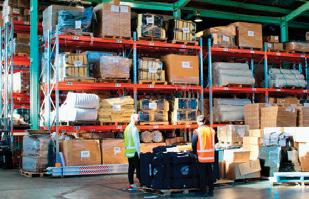
Vehicle tracking
VEHICLE SHIPPING
Approved MPI transitional facilities and cleaning services

GENERAL FREIGHT

VEHICLE TRACKING

SHIPPING SCHEDULE
Capping it all off is Jacanna’s SmartTrade Rewards Programme, you can earn points for almost any reward you choose

We are specialists in transporting and exporting all types of Vehicles, Commercial trucks, vehicles of Special Interest and other RORO Heavy Cargo & Machinery.
We have developed a worldwide network of Agents who understand the commitment required to service our demanding market.

Finding out where your vehicle is at any one time of the process, gives you the ability to manage the collection and processing of documents and payment on time.
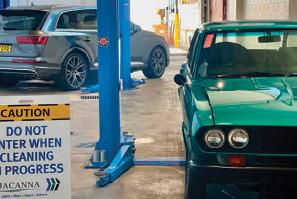


TRS and shipping services from Japan to New Zealand. www.jacanna.co.nz


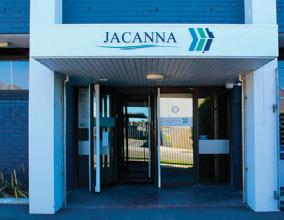
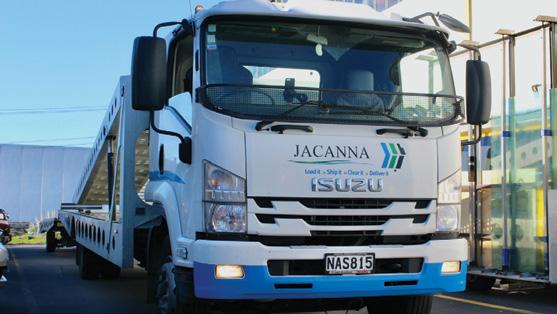
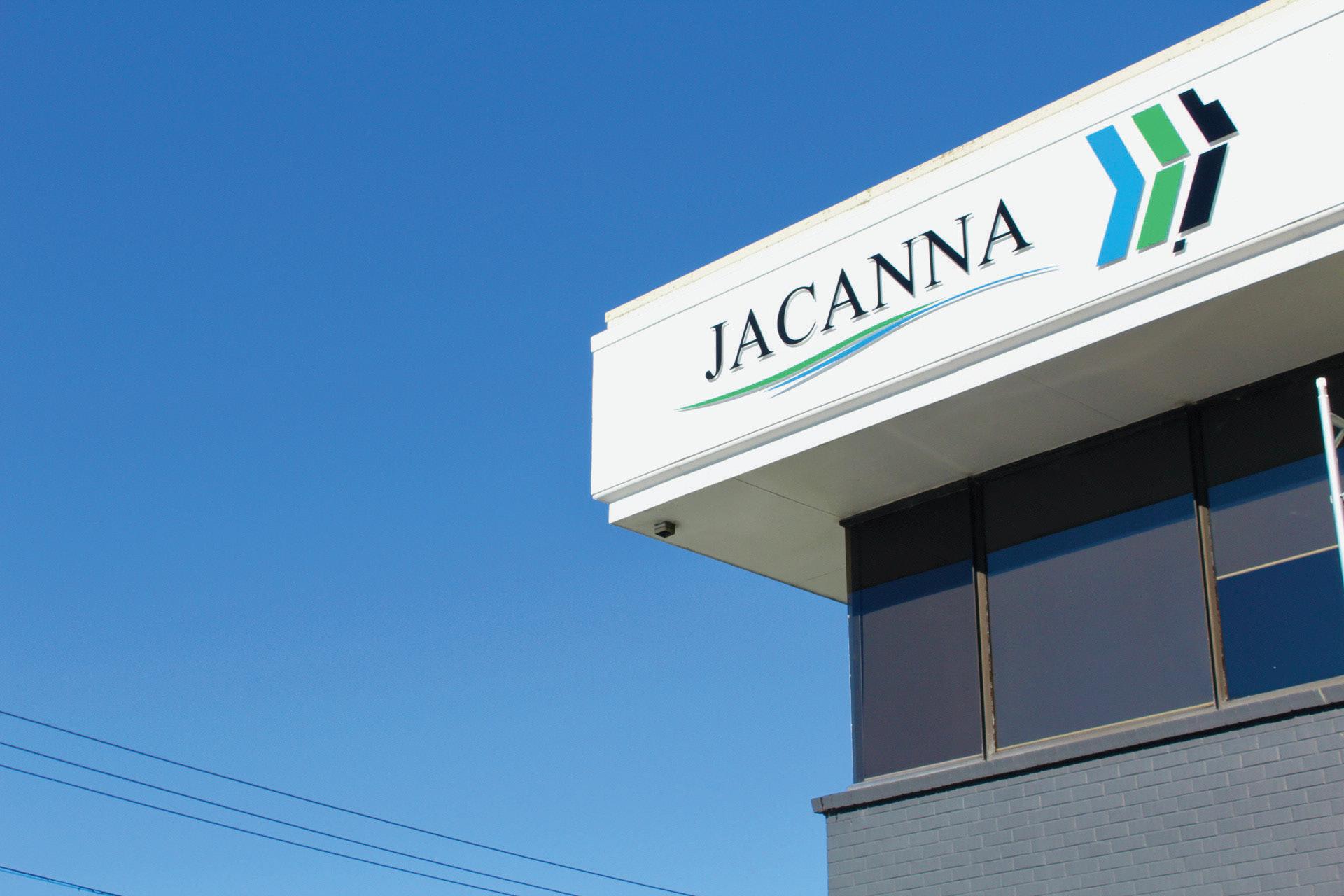

JACANNA.CO.NZ
www.jacanna.co.nz Tel: +64 9 825 0888
info@jacanna.co.nz Tel: +64 9 825 0888 Terms and conditions apply.
‘Perfect end to best job I have ever had’
This is my last month as chief executive of the Motor Industry Association (MIA). Having been appointed in September 2012, I took over the reins in late February 2013.
DAVID CRAWFORD Chief executive, Motor Industry Association

It has been an interesting ride and, in my time here, the early major issues we faced were the electronic stability control rule followed by the mandatory Takata airbag recall.
However, those pale into insignificance when compared to policies implemented by the Labour/Greens coalition and then rammed down our throats by the current Labour government.
The clean-car policies are forcing the greatest change across our sector in decades. It’s not that we don’t want the change because we do, but it is the rate of change achievable that’s critical.
The new-vehicle sector has long held the view that we need to do more to decarbonise transport and we are willing to more than play our part. However, as a technology taker combined with an annual consumption of just under 0.18 per cent of new vehicles produced globally in any one year, it’s important we leverage technology as a fast follower and not as a world leader.
Our market works to a derived demand model – we import what consumers and businesses want to buy.
The clean car discount was supported by the MIA as an initial lead into encouraging consumers


to consider lowemissions vehicles.
We supported the clean car standard as a follow-on intervention so long as the targets followed two years behind Europe by 2030 and did not get ahead of their current targets. A sensible and challenging, but probably doable, course of action.
We all know the answer was to ignore industry’s advice.
A question I have been asked recently is what has been the most frustrating part of my job over the past 10 years? The answer is simple. That’s ministers and officials who do not understand the way our sector works, and who often ignore the sane and sensible advice we provide.
I shall not miss this one single bit. That’s not to say all interactions with officials have been frustrating because they have not. Some have been exemplary.
What I will miss, however, are the interactions with the sector. People at the MIA’s member companies have been a pleasure to work with, always helpful and willing to answer my questions.
The industry is dynamic and a disruptor. New technology is always coming at you at pace.
I’ve spent the past decade in the best job I’ve had over my long and varied career, and now is a perfect way to end it. Retirement beckons, as does my ignored motorbike and hardly used caravan.
So long and thanks for all the fish. The journey has been one hell of a ride.
DIRECTORS
Brian McCutcheon brian@autofile.co.nz ph. 021 455 775

Darren Wiltshire dazzz@autofile.co.nz ph. 021 0284 7428
DESIGNER
Adrian Payne arpayne@gmail.com
EDITOR
Darren Risby ris@autofile.co.nz
JOURNALISTS
Sue Brebner-Fox sue@autofile.co.nz
Matthew Lowe matthew@autofile.co.nz
MOTORSPORT
Mark Baker veritas.nz@xtra.co.nz
Autofile magazine is also available online as a readable file or downloadable as a PDF. Subscriptions are available at Autofile Online – www.autofile.co.nz Back copies are also available on the website.
Copyright: Published monthly by 4Media Ltd

All statements made, although based on information believed to be accurate and reliable, cannot be guaranteed, and no liability can be accepted for any errors or omissions. Reproduction of Autofile in print or digital format in whole or part without written permission, whether by copying or any other means, is strictly forbidden.
All rights reserved. ISSN 0112-3475 (print) ISSN 2350-3181 (online)
www.autofile.co.nz 3 Vehicle Inspection NZ Entry Certification Specialists 0800 GO VINZ VINZ.CO.NZ • Entry Certification • Vehicle Appraisals • Pre-Purchase Inspections • Warrant of Fitness (WoF) • Certificate of Fitness (CoF) • Road User Charges • Registration & relicensing • Exhaust emission testing
Call Steve Owens now on 021 947 752 GUEST EDITORIAL
David Crawford says clean-car policies are forcing biggest industry change in decades
executive, says the association is working collectively and cooperatively on the matter with various authorities.
It recommends companies providing insurance and warranties consider changing how they define the value of a vehicle to reflect the impact of the clean-car policies.
This is because VIA believes – at retail level – that the value should be the retail price plus or minus the CCD penalty or rebate.
For stock on dealers’ yards that’s unsold, the insured amount should be the cost price plus or minus the CCS penalty or credit.
“The price of a car alone isn’t the price it should be insured at as it’s affected by the clean car discount or standard,” adds Vinsen.
“A $5,000 penalty or $3,000 credit may apply, so this money has to be allowed for to ensure insurance adequately covers a vehicle if it’s written off.
“Another suggestion we’ve made is for the Insurance Council or ourselves to lead discussions
on this matter because insurance companies can’t really talk to each other directly about it due to commercial sensitivity.
“However, through an industry association, those companies can have policy direction to help them understand these matters.”
VIA acknowledges one of the complications is how the CCD is applied by dealers, depending on whether they are selling a zero or low-emissions vehicle or one that’s considered a high-emitter by the government.
When consumers buy lowemitting models, they pay the full
price and the feebate’s scheme subsidy is then remitted to them following registration.
But for less-efficient vehicles, some dealers have been paying to register them and rolling penalties into sales prices to try to make the purchasing process easier.
“We don’t know exactly what this will mean for insurers and finance companies,” says Kit Wilkerson, VIA’s head of policy and strategy. “However, we’re trying to make everybody aware so they can make good decisions when dealing with it.
“Ultimately, it may not mean much for the everyday running of most businesses, but it’s something they should know.
“This has come to light with recent weather events. We’ve been thinking a lot about companies having to pay out insurance and the replacement cost of vehicles.
“It’s our understanding the NZTA agrees with our interpretation of deciding the value of a car and a recent Motor Vehicle Disputes Tribunal case does also.”
The case surrounding a rejected 2015 Nissan e-NV200 G resulted in the consumer being entitled to receive a refund of the purchase price, minus its $3,450 rebate.
Wilkerson contends a vehicle’s value could change in a short time post-supply because of the CCS’ impact. “A dealer or consumer may buy a car today and insure it for its replacement value at that time. But within a year, the CCS will have shifted its target meaning there’s going to be a bigger penalty on it, which will affect its price and value.”
He says the clean-car policies, overall, may lead to insurance premiums becoming more expensive every year that an owner has a car, which in turn may
influence the fleet’s age or lead to people not insuring older models.
Alternatively, everyone’s premiums may simply get raised to cover the increasing costs companies risk facing when insuring vehicles.
In terms of availability of used-imported stock to replace write-offs because of flooding and the cyclone, Wilkerson expects the industry will be able to meet any increase in consumer activity.
He notes dealers are importing fewer cars at present due to decreasing demand with levels “creeping below” the usual 130,000 units a year.
“I think there’s plenty of capacity to import more if demand increases because of people having to replace cars,” he says. “The flooding might prove to be a boon for some in the industry as people seek replacements, but there may also be added costs to consumers and insurance companies.”
Meanwhile, Waka Kotahi has issued a reminder to dealers that CCS charges may still apply to flooddamaged stock and this should be raised with insurers when making claims. It notes a vehicle accepted into a CO2 account is subject to CCS regulations and any charge on it “remains an obligation” even if now written off.
If an import hasn’t completed entry certification and has not been accepted by the CCS account holder, its replacement cost for insurance purposes remains unaffected by the rules.
“One part of the recovery from Cyclone Gabrielle is the issue of insurance and loss adjustments for flood-damaged vehicles,” it says.
“The CCS is a new aspect of business and so may not be front of mind as work is undertaken to restore people’s lives and businesses, but it is relevant.

“Importers and dealers holding damaged stock subject to claims should discuss the value of claims with their insurers if they are looking for full cost recovery.”
SCALE OF PROBLEM
The Financial Services Federation (FSF) has long held concerns about how vehicle values for finance
4 www.autofile.co.nz
If you are a forward thinking motor vehicle trader, or financier, looking for a trusted vehicle insurance partner, call Quest. Contact: Russell Bowater 021 790 365 russellb@questinsurance.co.nz QUEST INSURANCE OFFERS: an independent choice Mechanical Breakdown Insurance – backed by AA Roadside Assist Comprehensive Motor Vehicle Insurance Lifestyle Protection Insurance Credit Contract Indemnity Insurance Mechanical Breakdown Insurance for Electric and Hybrid Vehicles Guaranteed Asset Protection Insurance
news [continued from page 1]
We thought it would be a problem, but weren’t expecting it would be on the scale we’re now facing Lyn McMorran
and insurance purposes are determined, saying the clean-car policies “effectively manipulate” those figures.
Lyn McMorran, executive director, told Autofile the CCD means there are always going to be questions about values for reselling or replacing cars after fees have been paid or rebates given.

“We thought it would be a problem, but weren’t expecting it would be on the scale now faced,” she adds. “Thousands of vehicles are being written off because of these terrible weather events. The question will be how we replace them.”
The FSF wants the government exemption from requiring a complete full affordability assessment under the Credit Contracts and Consumer Finance Act (CCCFA) extended to the nonbanking sector.
People can currently access $10,000 in extra credit if affected by Auckland’s anniversary weekend floods and or Cyclone Gabrielle, but only on home loans or via temporary overdrafts.

McMorran warns product-specific measures means a significant number of Kiwis cannot get financial help to rebuild their lives.
“The FSF is pleased officials have acted to help support New Zealanders, but the decision not to extend exemptions to personal loans or other credit products restricts relief for people really needing it.
“During consultation, we made it clear home loans and overdrafts weren’t the most suitable products for the type of lending people need to help get back on their feet because, for many, a vehicle or household item is their biggest asset.
“It’s logical that products offered by non-bank lenders specialising in lending against household items and vehicles would be of greater use.”
In the case of an overdraft, people wanting to replace flood-damaged items will have to arrange finance before they can buy cars and appliances.
Many are used to going to dealers, for example, to buy vehicles and secure funds to do so at the same time.
“They don’t want to have to go somewhere else to organise finance, which they will have to do with an overdraft,” says McMorran. “An overdraft is also likely to be unsecured so this forces people into higher interest-rate products, which makes it more difficult for them to access funds.”
McMorran adds the only reason she can think of against including non-bank lending is concerns people may access up to $10,000 from high-cost lenders without having to meet the CCCFA’s affordability criteria.
“The solution would be for the regulations to exempt high-cost lenders, but allow specialists in vehicle financing and retail to help these people.”
She stresses FSF members are “responsible lenders” and will be doing what they can to assist borrowers struggling in the aftermath of the violent weather.
One company has advised its call-centre staff that if customers get in touch to say they’re unsure how to immediately meet payments, to tell them the next two installments will be postponed.
“A grace period is one intermediate solution to one problem until the borrower can think about it again and have more clarity about what their situation is going to be,” says McMorran.
“The Business Support Network is also saying to government we need to look into reinstating wage subsidies for affected businesses so people can still be connected to their jobs and get paid.
“We’ve got precedents with Covid-19, and the Kaikoura and Christchurch earthquakes. Wage subsidies helped people get through those tough times and
that would be the case for many businesses hit by recent events.”
WRITE-OFF LEVELS
About 10,000 vehicles damaged in the floods over the past two months are expected to be written off by insurers.
Greg Hedgepeth, chief executive of Turners Auto Retail, describes that figure as a best estimate that excludes uninsured cars, which are the big unknown.
The Insurance Council estimates that around 90 per cent of vehicles are insured, while one-in-10 policies cover third party, fire and
theft but not flood damage.
Turners handles around half of insurance write-offs under contracts with Suncorp, which owns Vero and AA Insurance, Tower and some of the smaller companies.
Hedgepeth believes his company will handle about 5,000 with most flood-damaged vehicles being declared write-offs.
Manheim handles IAG’s write-offs. As of February 24, IAG brands AMI, State and NZI had received 4,903 vehicle claims because of recent weather events. Of these, it estimates 85 per cent will be total losses.
Written-off cars are deregistered and entered onto Waka Kotahi’s damaged-vehicle database.
An agency spokesperson says 567 water and fire-damaged vehicles had been added to that database from February 1-24. Another 317 had been notified, but had to be processed before being added to the list.
Advice for dealers on flood-damaged cars – page 21
www.autofile.co.nz 5
t
news Contact us now to find out more A better deal for the Motor Vehicle Trade Ph: 09 320 5646 www.autobridge.co.nz n Flexible credit facility available to fund vehicles in transit or on your yard n Access to stock when you want to buy, not only when you have the available cash
Free up your capital and grow your business
Only available to registered motor vehicle traders
n
n
About 10,000 flood-damaged vehicles are expected to be written off
Association makes call to action
Importers of used vehicles are being urged to continue challenging what they believe is incorrect emissions data when it comes to the clean car standard (CCS).
The “call to action” has been issued by David Vinsen, chief executive of the Imported Motor Vehicle Industry Association (VIA).
Since the association withdrew its support for the clean-car policies last year, VIA and the government have received fewer complaints although he says “we’ve heard this is more likely due to apathy and not satisfaction or resolution”.
The CCS has proved troublesome, especially for used-vehicle importers, since it was rolled out on January 1 with many issues stemming from Waka Kotahi’s systems.
“We strongly recommend that importers challenge any incorrect vehicle data even if there’s an expectation of failure,” adds Vinsen. “There have been fewer complaints lately, so the government may be thinking that it’s got it right.
“However, our advice is you need to ensure you get data issues clarified even if you don’t think you will get them across the line.
“The government has had difficulties and challenges identifying specific vehicles and matching them to its dataset, and we’ve been trying to help the NZTA
address this issue since the programme’s launch.”
VIA is concerned the lack of a comprehensive online mechanism that allows suppliers to look up “official” data and lock it in leaves the industry without a meaningful option. While a quick look-up tool is now being worked on by the agency, the absence of one has been frustrating.
And problems with the treatment of data for used imports, such as the way the efficiency of plug-in hybrids (PHEVs) is calculated, are “perverting the intended influence on demand”, says Vinsen.
As for CCS penalties that have accrued since January, VIA warns there are risks associated with these when they become due on June 1. Some businesses may not understand their obligations and may not be setting aside funding to cover the charges incurred.
VIA recommends importers check their carbon dioxide (CO2)
VIA says problems with data for used imports, such as the way the efficiency of PHEVs is calculated, are “perverting the intended influence on demand”
hosted a webinar on February 14, which was attended by Autofile, to discuss the impacts of the CCS and clean car discount (CCD).
Kit Wilkerson, head of policy and strategy, said the policies’ inflationary pressures were “especially strong” for the used-imports sector because its “compact supply dynamic” competes with dealers from other countries and those in Japan to source vehicles for New Zealand.

accounts and make arrangements to set aside appropriate amounts of money.
Vinsen says there’s an opportunity for industry service providers to assist their customers by reminding them of their obligations.
Matters they can raise include if they have CO2 accounts, if they’re monitoring them, if they know what they currently owe and if they are aware of what total will be in three months’ time.
“The CCS costs keeps accruing and will become due in June,” he adds. “Our concern is importers may not be monitoring their accounts for those costs. We advise dealers to put money aside for when they get an invoice from the government.”
FEARS OVER INFLATION
Industry experts have described the government’s clean-car policies as inflationary.
The issue came up when VIA
Full online systems delayed
The Motor Industry Association (MIA) is expecting Waka Kotahi’s fully developed systems that will oversee the clean car standard (CCS) to be in place by the middle of this year.
Chief executive David Crawford says there have been teething issues, which were predicted with the implementation of
the government’s policy. Many have resulted from the scale and complexity of the CCS.
“There have been a lot of wrinkles with the system and there have been several of them floating around at the same time,” he adds.
“We have been having regular meetings with the transport agency and we’ve been working
collaboratively to get them resolved. This has resulted in relatively good turnarounds when issues have come up.
“What we would say, however, is that the CCS is creating a lot more regulatory and compliance work for our members although we anticipated that. It was never going to be simple to set up.
“Every year the targets will become stricter for the clean-car programme and the supply of vehicles narrower. This will end up driving up the cost of vehicles.
“An argument could be made that this programme is hyperinflationary with knock-on effects on the cost of living for mid and low-income Kiwis.”
The CCD had achieved its purpose, Wilkerson noted, in that a lot of people had purchased PHEVs and EVs.
“The programme is based on what was launched in Europe for Europe. That was intended to encourage manufacturers to build more EVs and give subsidies on them to encourage people to buy more EVs.
“However, original equipment manufacturers [OEMs] have static supply channels, so it doesn’t work like that for us.
“When subsidies become available, auction houses and other suppliers in foreign jurisdictions just raise their prices.”
[continued on page 8]
“That said, the new-vehicle industry isn’t faced with as many issues as those operating in the used-car sector where business models are having to change a lot.”
In addition, the MIA is awaiting the outcome of the government’s review into the clean car discount, and its timelines for bringing in Euro 6 emissions standards for new and used petrol and diesel vehicles because of market impacts both policies will have going forward.
6 www.autofile.co.nz
news

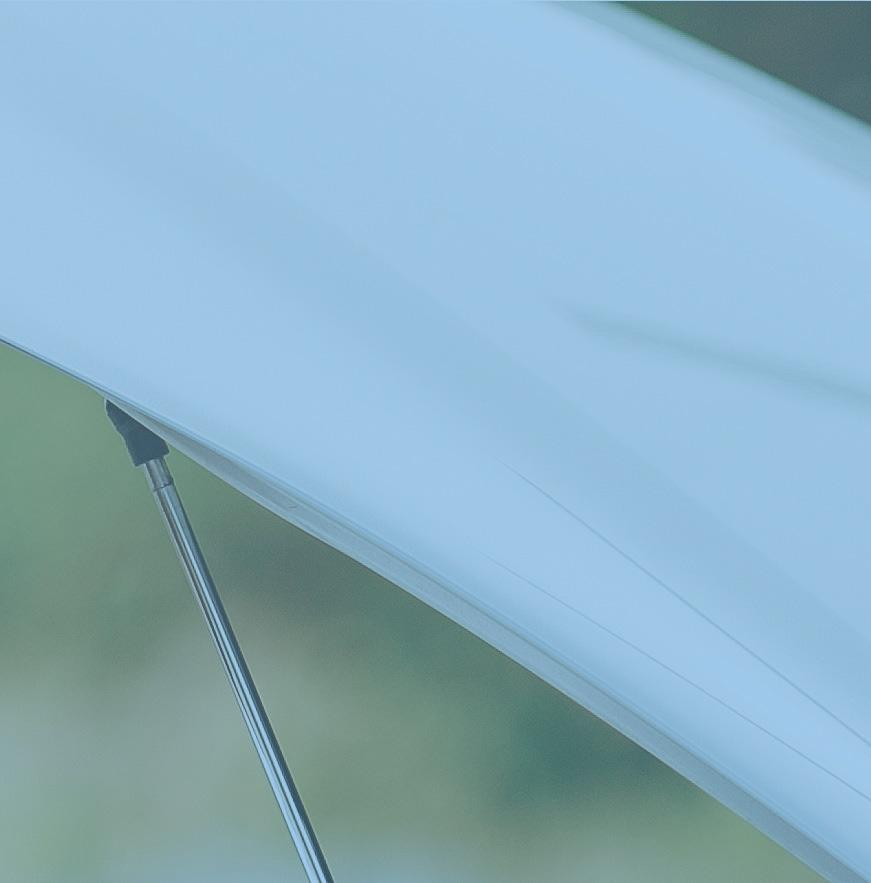



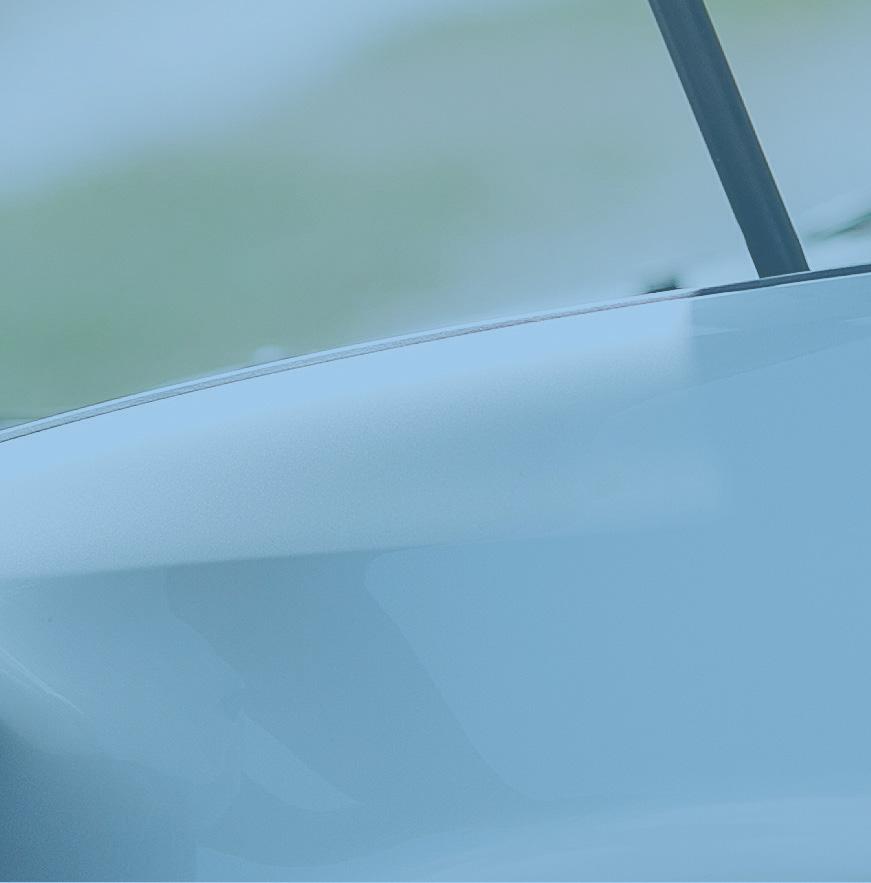
Offering Premium Insurance Products for your Customers Our bespoke online dealer training programmes and ongoing customer support make insurance easy for you and your team. We have been driving great partnerships for over 30 years. Why not talk to us about how we can add value to your business today? contact@protecta.co.nz | 0800 776 832 new.protecta.co.nz
VIA has been making the case this is inflationary for some time with costs being passed onto consumers.
The government has said it realises that’s the case, but it adds the policy has made New Zealand more competitive when coming up against other buyers of these cars.
Vinsen raised the issue of money running out to fund the CCD because subsidies are more than what can be recovered in fees.
“The government may either front-end load the scheme or cough up the money for it. Both of those things are inflationary.”
While Wilkerson said the government would probably need to change the legislation for these options to be progressed, Vinsen added it was a case of “fund it or review it” with scenarios including the CCD’s subsidies being reduced or penalties being increased.
Referring to a CCS management forum hosted by Moana Blue in Auckland on February 9, Vinsen said Simeon Brown, National’s transport spokesman, had since sought VIA’s advice on revising the clean-car programme so his party could “hit the ground running” if elected.
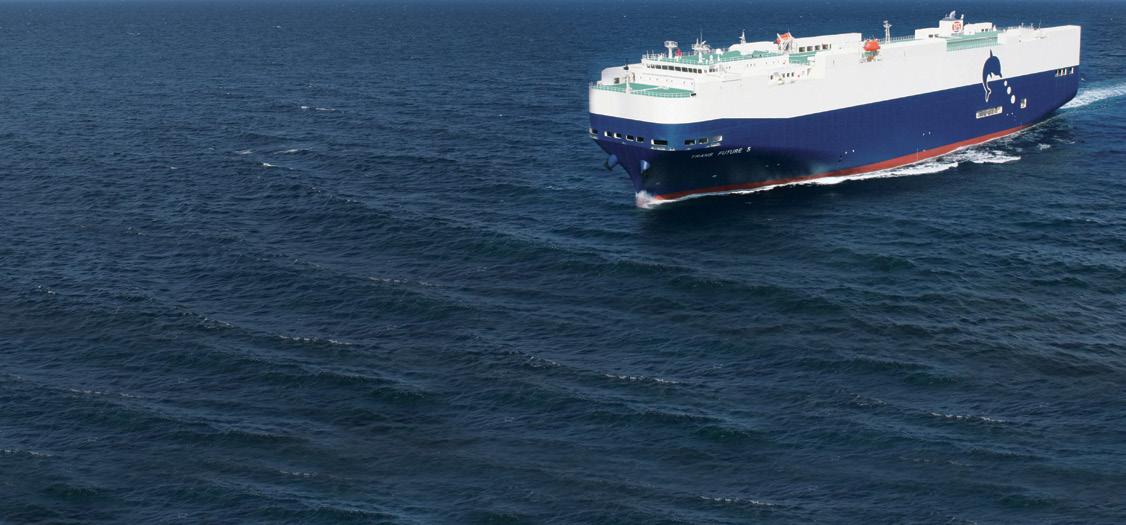
He added National wanted “a clear idea of what industry associations propose” and VIA has since agreed to lead an industry working group on revising the CCS.
So far, Labour has indicated there will be no changes to the clean-car policies although a Ministry of Transport review into the CCD is under way, and the Greens have suggested increasing its penalties.
National has said it will keep the CCS in some form with the system’s costs being hidden in sticker prices.
The party has added it’s committed to trying to form an industry solution to inform its policy, while Act wants the CCD and CCS abolished.
ACCESSING STOCK
The used-imports industry has consistently informed the government there’s insufficient stock when it comes to fully electric vehicles and PHEVs.
This was reiterated by Vinsen
FROM JAPAN TO NEW ZEALAND ON TIME, EVERY TIME

during VIA’s webinar. “Their shortage is such we cannot hit the targets. We’re last on the list for quota and new-vehicle distributors are struggling to get their quotas increased.”
Wilkerson tackled supply issues with the CCS. The industry might “break neutral” in 2026 when it comes to balancing CO2 credits against penalties under the standard.
However, everything after that will “become negative when it comes to our current supply of vehicles and we cannot see there being a dramatic difference by then”.
Half of used imports coming in are already hybrids and by 2027/28 there will be few EVs available from Japan.
“It’s already getting harder to sell used EVs to consumers
globally because they don’t want batteries that have already been used,” explained Wilkerson. “OEMs could start building cars to take replacement batteries, but that doesn’t appear likely.”
He predicted 2030 would be “significant” for used-import volumes to New Zealand, while the years towards the end of the decade “are going to get very painful”.

More cheap, new EVs made in China are likely to come to market at around the $40,000 mark while “penalties on our vehicles will be significant”.
“We should still be able to import $20,000 to $30,000 cars, but should be prepared for them to be older and higher mileage and have penalties attached to them,” said Wilkerson.
Vinsen commented that used EVs had led the way with Kiwi consumers and those imports had put pressure on the new-vehicle distributors to bring in more new EVs for fleets. “That seems to have worked, but the balance has now changed.”
As for New Zealand in 2022, Tony Everett, sector manager –dealers at the Motor Trade Association (MTA), said about 17,000 new hybrids were imported last year compared to 34,000 used.
He added there were about 16,000 new and 4,000 used EVs

8 www.autofile.co.nz Contact:
Stone adam.stone@toyofujinz.co.nz www.toyofujinz.co.nz
Adam
T/S = Tranship to next available TFS vessel
JAPAN
Toyofuji vessels Voyage
NEW ZEALAND
Dream Jasmine 25 17 Feb 19 Feb 21 Feb 7 Mar 11 Mar 10 Mar 13 Mar Trans Future 6 142 16 Jan 17 Jan 21 Jan 16 Mar 20 Mar 21 Mar 22 Mar New Century 2 177 27 Feb 1 Mar 2 Mar 4 Mar 22 Mar 25 Mar 27 Mar Trans Future 7 142 29 Jan 31 Jan 4 Feb 23 Mar 27 Mar 29 Mar 30 Mar Dream Angel 33 10 Feb 13 Feb 14 Feb 18 Feb 30 Mar T/S T/S T/S
Moji Osaka Nagoya Yokohama Auckland Lyttelton Wellington Nelson
TOYOFUJI SHIPPING SCHEDULE
[continued from page 6]
news
Parts of Waka Kotahi’s importers’ dashboard for the CCS
registered in 2022. The PHEV totals for new and used were low, “almost irrelevant”.
As for the CCS, Everett said it appeared many dealers still didn’t know how the system worked.
As an example, he cited a trader he had spoken to in mid-February. The dealer had just imported his first car under the standard when the policy had been in place for one-and-a-half months.

“We’ve had quite a lot of discussion around some who are working the CCS through in their heads wildly inaccurately.”
Everett highlighted articles in Autofile that had advised dealers to avoid taking the government’s emissions data as read and to seek out more accurate data, especially when importing European models from Japan.

He emphasised businesses needed to “get their heads into game” now as far as the CCS was concerned because its penalties will only get worse.
Brian Anderton, the MTA’s
advocacy manager, was also invited to VIA’s online debate on February 14.
He said the association was aiming to publish its advocacy manifesto by May 9 on everything it would like the next government to deliver on.
Anderton added reducing pollution from transport in-line with the emissions reduction plan (ERP) published last year was unlikely to be reached if the CCD and CCS weren’t in place, and he emphasised that it was important for the industry to look at other
tools the government could use.
“The ERP needs to be top of thinking. We have to be able to present other options to get emissions reduced and move towards better solutions.”
Vinsen tackled the issue of how targets in the ERP could be achieved in the hypothetical absence of the clean-car policies.

“For National, the emissions trading scheme should be the primary mechanism so secondary schemes aren’t needed,” he said.
“It’s suggesting some sort of carbon tax is needed… but
no government would have the guts to put that in place because it would be inflationary and unpopular, so it’s stuck between a rock and a hard place.”
Everett said it seemed a bit like revisiting discussions from two years ago when there was a preference for a tax at the pump being the biggest influence on limiting the use of vehicles.
Wilkerson pointed out: “That was also our position. The best way is to put the cost on fuel.”
Moving forward may ultimately hinge on political will. Vinsen said: “VIA and other associations are continuously working on these issues. It’s like Groundhog Day and going back to square one.”
And there’s a bottom line with the clean-car programme. As Wilkerson remarked: “There’s a lack of used EVs for our industry to import and a lack of credits to offset penalties. When it comes to availability, the market isn’t there. We’ve got to be unified and push through this”.
www.autofile.co.nz 9
t news
David Vinsen, chief executive of VIA Brian Anderton, the MTA’s advocacy manager
New chief joins at ‘pivotal time’
Aimee Wiley has been appointed to take over as chief executive of the Motor Industry Association (MIA).

She will replace David Crawford when he retires later this year after what the organisation describes as a “lengthy and thorough” recruitment process.
Wiley’s experience in the automotive industry includes working for Ford NZ and Ford AsiaPacific on product development.
She was most recently programme director for lowemissions vehicles (LEVs) at Waka Kotahi New Zealand Transport Agency where she worked on the clean car discount and clean car standard.
“Aimee was selected for her extensive professional experience, formal education and unique skill set,” says Simon Rutherford, president of the MIA.
“She has a wealth of senior experience spanning the business sector. Aimee will bring with her knowledge of and connection with government processes, leadership skills, and formal qualifications in accountancy and business law.”
Wiley’s appointment, which was first reported on by Autofile Online, was announced on March 3.
She starts with the MIA on April 1 and will be working with Rutherford and Crawford over the next three months to ensure a smooth transition.
“Our members are thrilled Aimee is taking up the role of chief executive officer at a pivotal time for the industry,” adds Rutherford.
“We would also like to recognise the huge contribution and dedicated service David has provided in his tenure as the MIA’s CEO.”
Wellington-based Wiley joins the association after previously
being programme director for LEVs at Waka Kotahi from March to November 2022.
She joined the transport agency after working for BRANZ –the Building Research Association of New Zealand – where she was the programme manager for campus redevelopment for almost two years.
Wiley started her career as a marketing finance analyst for
Ford NZ in 2005 before becoming finance manager at Carter Holt Harvey in 2007 for three years.
She was then appointed as financial controller at Agriturf Ltd (John Deere). That was for two years.
After that, Wiley joined Ford Australia in March 2012. Based in Melbourne, she was the company’s manager of product development for almost six-and-a-half years before becoming group chief financial officer of Habit Group in May 2019.
Crawford announced in March 2022 that he would be stepping down from his role. He has been working in the transport sector since 1996 and was appointed by the MIA in September 2012 before starting in February 2013.
He says: “I’ve spent the past decade in the best job I’ve had over my long and varied career, and now is a perfect way to end it.”
Biofuel costs avoided
The Motor Industry Association (MIA) is “relieved” the government’s biofuels sales obligation will no longer be implemented.
Chief executive David Crawford says biofuels will always be an option to use in some vehicles, especially in the heavy sector, as New Zealand shifts to lower CO2-intensive transport.
He adds: “However, a mandatory obligation with the stated purpose of reducing carbon-dioxide emissions isn’t needed because the transition to an ever-increasing electrified fleet is reducing emissions at a fast rate.
“Sales of vehicles with some form of electrification to fully electric vehicles grew from 14 per cent in 2021 to 25 per cent in 2022.”
The increase in registrations of electrified vehicles last year led to a big reduction in the average
sales-weighted CO2 emissions rate from the light-vehicle fleet. It dropped from 187.1 grams of CO2 per kilometre in 2021 to 167gCO2/km in 2022.
That represented a 10.7 per cent decrease in one year – the largest reduction “by far” since the MIA started tracking such emissions reductions in 2006.
“Biofuels are expensive to produce and the MIA welcomes the government’s decision to not proceed with a mandatory biofuel sales obligation,” says Crawford.
“This will help keep motoring costs down at a time when New Zealand is facing strong inflationary pressures across our economy.”
The Ministry of Transport’s website explains “biofuel” as a generic term for fuels that can be produced from or are made up of a renewable material of plant or animal origin. They are often substitutes or partial substitutes for fossil or mineral fuels.
10 www.autofile.co.nz
news
Contact us today 09 966 1779 www.jevic.com SP E C I A L IS T S I N PRE‑SHIPMENT INSPECTIONS MPI biosecurity inspections Biosecurity decontamination Heat treatment NZTA border inspections Odometer verifications Pre-export appraisals ? Lost documentation reports
Aimee Wiley
a faster and more flexible way to get behind the wheel
New Zealand’s non-bank vehicle lending specialists, just got faster and even more flexible.

We offer a first-tier proposition, second-tier finance options, and wholesale floorplan finance. Our flexible solutions get your customers on the road faster and keep you moving forward with automated systems for smooth, uninterrupted journeys.
We provide access to an experienced team of lenders, outstanding personalised seven days a week service and nationwide coverage. We work where you work.
Curious to find out more?
Lee Robson, National Sales Manager, NZ Dealer 027 688 9895 | lee.robson@avantifinance.co.nz
Nicole Remkes, NZ Broker Manager, Auto & Consumer 021 599 729 | nicole.remkes@avantifinance.co.nz
www.autofile.co.nz 11 Lending criteria, fees, terms and conditions apply.
*For complete and correct applications which meet our responsible lending criteria. Fees, terms and conditions apply. Our process will take longer if the application is not complete and/or we require further information in order to make a credit decision. NEW VEHICLE FINANCE brandedfinancial.co.nz USED VEHICLE FINANCE avantifinance.co.nz
Tackling end-of-life vehicles
It may have taken more than a decade to get a project in place for old tyres, but industry experts are hoping the road to creating nationwide recycling systems for other parts of vehicles will now be smoother.
Auto Stewardship New Zealand (ASNZ), which provides governance and support to automotive-related stewardship schemes, has played an instrumental role in helping bring Tyrewise to fruition.

This project to recycle end-oflife tyres (ELTs) aims to minimise their environmental impacts by managing them from collection through to processing.
The idea got off the ground in 2012 and was received with enthusiasm by Amy Adams, then Minister for the Environment, when it was presented to her the following year.
However, it was not until July 2020 that tyres were declared a priority product under the
Waste Minimisation Act, enabling Tyrewise to forge ahead. The scheme is now expected to launch in late 2023.
Mark Gilbert, chairman of ASNZ, is looking forward to the nationwide programme starting and work is already under way to create similar systems for other vehicle parts.
“We set up ASNZ to say if we can get this right with tyres, why not use that intellectual property to attend to all other areas of a car and what comes out of it when it’s broken down,” he told Autofile.
“With Tyrewise, we know what’s got to be done and how it’s got to be done. Now it’s a matter of getting people in place to get it going.
“Batteries in electric vehicles [EVs] are now another product we can work on as they have been declared a priority, but this will take time. We will work with government on agreeing processes and milestones. We spent 10 years doing this with Tyrewise.
Gilbert says that ASNZ is in the early stages of working with the 3R Group, which has project-managed Tyrewise, and the Ministry for the Environment on what an end-of-life battery programme could look like.
There are no set dates for introducing a battery scheme, but work involves consultation with industry figures and the Energy Efficiency and Conservation Authority.
“It’s a work in progress, but we’re advocating for it,” adds Gilbert. “There’s lots being done mainly by people in the 3R Group, but it’s a slow burn on batteries. It’s not like tyres where issues obviously exist.
“We’re also monitoring what’s going on in other parts of the world. One thing to consider on how we’re going to deal with batteries is whether we will have the critical mass to justify investment in pulling them apart and trying to recycle them.

“We’re also not a carmanufacturing country that’s looking to get minerals out and put them back into new vehicles. A stewardship scheme for EV batteries is a long way off, but nevertheless it’s getting closer.”
There may be scope to add extra automotive-related stewardship schemes. The government is looking to introduce scrappage “and we feel ASNZ might be qualified to have a role in that”.
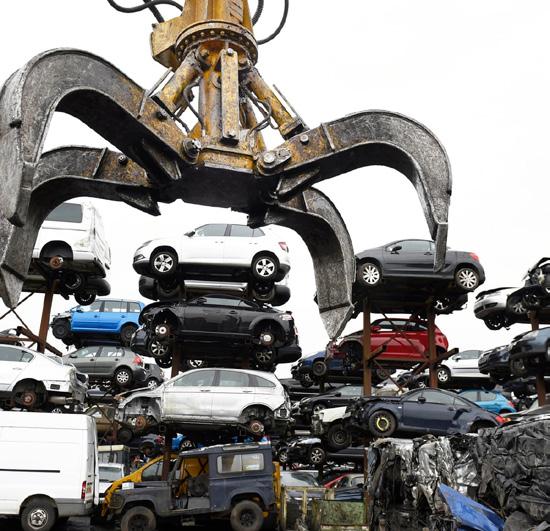
The government announced in May 2022 that it will run a scrapand-replace trial of up to 2,500 vehicles from early this year.
We are
looking
for NZ-new
with less than 150,000km
Fords and Mazdas. Ideally 2012 or newer
If you
have something you'd like priced, contact
Jason: 0274 133 222
| jason.robb@southaucklandmotors.co.nz

“Hopefully, it won’t take that long with batteries because we have learnings from Tyrewise to advance this project if both the ministry and ourselves draw on our past experience and knowledge.”
Called the clean car upgrade, it will provide targeted assistance to lower and middle-income households to shift to lowemissions alternatives in exchange for getting rid their old vehicles.
If the pilot proves successful, it will be rolled out across the country and has been touted as a key initiative in the government’s emissions reduction plan.
Gilbert says with people
12 www.autofile.co.nz news
ASNZ says there’s an opportunity to steer away from just wrecking vehicles when they exit the fleet
twrecking cars every weekday in New Zealand, the opportunity is there to do more with them.
“We’ve got an old and potentially unsafe fleet so there can’t be more cars just going to wreckers’ yards over time. We need to look at how we handle that.
“There are components, fluids and metals and more in those vehicles. It’s an industry opportunity to do something different and not simply wreck entire cars.
“You want to try to do something when there’s a product with value to someone else. It’s about creating a more circular economy. But there are a lot of products in vehicles that aren’t appropriate for recycling, so we need to get on top of that as well.”
Gilbert and four others currently make up ASNZ, which is a not-for-profit charitable trust.
Its other members are David Vinsen, chief executive of the Imported Motor Vehicle Industry Association, Sturrock
Saunders, who is a director of the Motor Trade Association, Peter Ryan, chief operating officer of electricity, gas and fibre at Vector, and Kerryn Downey, formerly a senior partner of accounting firm McGrathNicol.
ASNZ was originally established in 2013 to provide the governance structure for Tyrewise, “ensuring money is coming in and

being handled appropriately, and that milestones agreed with the ministry are being met”.
Stakeholders have since committed to progressing wholeof-vehicle stewardship.
“We’re here to help sectors of the industry take responsibility for what happens at the end of a vehicle’s life,” explains Gilbert.
“Sustainability is over the top
of all of this. Everyone is good at coming up with sustainable strategies, but not so good at implementing them.
“New Zealand being small means an individual car company might say a stewardship project is too hard, but as a collective – and if the industry gets behind these things – there’s more scale and options to do something.”
The subject of recycling batteries from EVs was advanced by Vector a few years ago and the company looked at possibilities, which led to the creation of the Battery Industry Group.
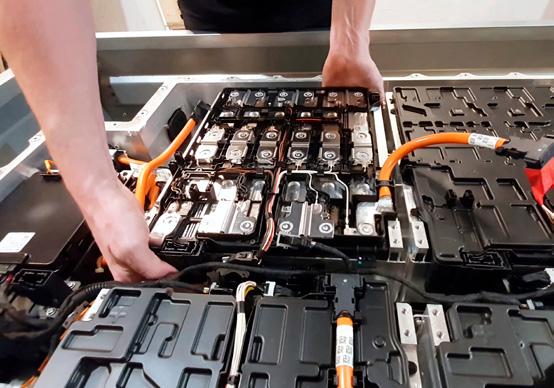
Changes in personnel have led to that group, which describes itself as a collaboration between more than 170 business, individuals and stakeholders across the energy, waste, transport and battery sectors, now operating under ASNZ’s governance.


Gilbert says most people in the automotive industry want to do the right thing when it comes

www.autofile.co.nz 13 Why not ask what SBL can do for you? Every year we import thousands of vehicles into New Zealand. We manage every detail of the importing process from Japan to your door. For our approved customers SBL Finance can provide flexibility in funding a vehicle’s purchase. Ph. 03 377 6578 www.sbltd.co.nz Call us now and find out what everybody’s talking about.
news
[continued on page 14]
It will take time to get a product stewardship scheme for end-of-life batteries from electric cars up and running in New Zealand
to end-of-life products and he expects that will become easier over time.
He notes Tyrewise, which will deal with millions of tyres annually, has been a long time in the making after he first got involved in the project’s working group in late 2012.
Issues with ELTs, such as dumping and illegal fires, have been motivating factors for creating a process that manages them with more compliance and more bite.
“It’s about political will and timing,” says Gilbert. “In 2013, we presented the Tyrewise idea to Amy Adams. It has taken two terms for the Labour government to push this through and finally get it under way.
“That’s just the process with government. Things like this won’t happen tomorrow, but it’s great we’re on the final stage. Then we can look forward as quickly as we can to the next project within the constraints we may have.”
Gilbert is proud to be involved with a small group working in product stewardship. His only disappointment around Tyrewise has been Waka Kotahi New Zealand Transport Agency not signing up to use recycled tyres for resurfacing roads and highways it manages.
Operations in other countries, including Australia, use powderised tyre rubber instead of importing emulsifiers to help make road-surface products.

“Unfortunately, Waka Kotahi has
just recently signed a seven-year contract with people who supply emulsifier, so it means we’re not likely to get any traction in this area for seven years,” he opines.
“But seven years will come and go, and hopefully we will have the opportunity to work on that. Rubber and roads isn’t a new thing. It’s been successful elsewhere.
“With all the roading projects that need to be done in New Zealand 24/7, we will make our case and ensure Waka Kotahi is aware of what we’re doing so when decision time comes up again it will consider it instead of just using traditional emulsifiers.”
CALL TO INDUSTRY
The 3R Group is looking for future participants in the product stewardship scheme for ELTs to get in touch.
Chief executive Adele Rose says the registration of those taking part in it is a key focus for the first quarter of 2023.

An appeal has also been made
to those wishing to be involved in the project’s technical advisory groups to get in touch.
“We’re excited to be back working on the implementation of the programme as we get ever closer to launch later this year,” she says.
“As the Ministry of Transport and Waka Kotahi begin working together to review tyre-import standards, their representatives are keen to engage with importers.
“Whether you’re a seller or wish to provide your expertise and industry knowledge to a technical advisory group to continue the good work done by Tyrewise, please ensure we have your details.”
All importers, tyre retailers, generators, collection sites, transporters, retreaders, processors and manufacturers, also known as end users, must be registered as partners on Tyrewise’s database.
Most will then receive a site visit to assess access, typical volumes and ideal collection schedules. Processors and
manufacturers only need to register if they wish to receive incentive payments.
The overall aim of the scheme is to create a level playing field for all importers, which pay the same advanced stewardship fee for all new tyres at point of sale regardless of location. It means customers are no longer charged disposal fees for ELTs.
You may be able to claim rebates if imports are directly shipped to another country if New Zealand is used for trans-shipment. Evidence of this will be required.
Visit www.tyrewise.co.nz/ register-now for more details. It’s essential that if you import or sell tyres to get registered. This will enable the free collection of ELTs from registered participants once the scheme has been launched.
Six technical advisory groups will act as sounding boards for ASNZ and project managers.
They will provide specialist advice on key performance indicators Tyrewise will be measured against. They must be representative of the supply chain and include a mix ranging from large corporates to small entities, including not-for-profit organisations.
The groups being proposed will cover product and end markets, grants for market stimulation and research, importers of loose tyres and those on vehicles, transporters, the advanced stewardship fee review committee and tyres outside of scope, such as those on bicycles and non-motorised equipment.
Log onto www.tyrewise.co.nz/ our-people/#groups to find out more.
14 www.autofile.co.nz [continued from page 13] news
We’re excited to be back working on the programme
Adele Rose
Rubber-modified asphalt turns old tyres into new roads. It offers a more sustainable solution to maintenance and resurfacing of local road networks


www.autofile.co.nz 15 “An app that makes your life easier? That’s a wing-wing situation.” Introducing the all-new MTF Finance Dealer App Our brand new app is the first of its kind in New Zealand. It means there’s no need to wait on finance reps or have awkward conversations with your customers to get them finance. We’ll sort the loan for you, with your commission paid on the spot. Talk about easy. Find out more at mtf.co.nz/join Helping New Zealanders do more since 1970 Offer of finance is subject to terms, conditions and lending criteria. See mtf.co.nz/terms for details.
No magic bullet for supply
Affordability and availability will be key with the clean car standard moving forward because of the lack of electric vehicles (EVs) and plug-in hybrids (PHEVs) available to import used from Japan.
Eighty-five per cent of all lowemissions vehicles (LEVs) registered in New Zealand from 2021-22 were Japanese hybrids.
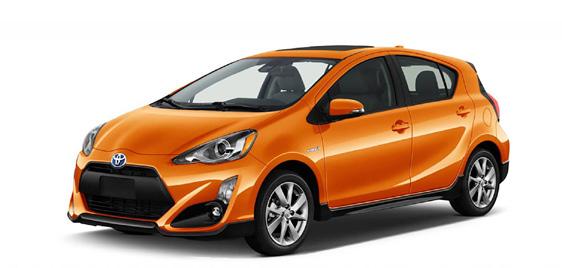
Those statistics mean the usedimports industry has already been punching above its weight, says Matt Battle, general manager of Moana Blue and a board member of the Imported Motor Vehicle Industry Association.
Petrol hybrids from Japan are New Zealand’s only significant source of credits for the clean car standard (CCS), especially with less than 60 ex-UK EVs and PHEVs being imported here last year.
Battle stresses the industry probably cannot change the mix of the fleet much more than it already has, with the five per cent of EVs and PHEVs not being “for the lack of trying”.
“Sales of new EVs in Japan are low because that market is so focused on hybrids,” explains Battle. “The UK isn’t much better and was lagging behind Japan for EVs until 2020. Those cars aren’t available as they will not be affordable for many years.
“Used hybrids really are our only source of LEVs and the pressure is on to keep them coming through.
“We need to ensure the clean-
car legislation doesn’t cut through our ability to bring in hybrids when they are no longer affordable because of the CCS. That would stagnate our fleet.”
Battle says there’s no magic bullet to secure EVs and PHEVs when the standard takes a sudden change of direction in 2026/27, at which time it will “become a
CLEAN CAR STANDARD TARGETS – grams CO2/km
FROM GAINING CREDITS TO ATTRACTING CHARGES
already transitioned to cleaner cars where they are affordable and available.”
can build up from today. As time moves through, targets reduce and the ability to maintain profits shrinks.
significant impediment” because what can be sourced for the local market will come down to affordability and availability.
He notes New Zealand’s usedimports mix “notably” changed from 2018-22. For example, hybrids climbed from 4.8 to 30.2 per cent of registered imports over the five-year period, while the combined total for battery electric vehicles (BEVs) and PHEVs peaked at five per cent in 2022.
Used imports with internal combustion engines dropped from 92.7 to 64.8 per cent of the overall total between 2018 and 2022, while Japan accounts for around 94 per cent of used vehicles crossing our border.
Battle says: “Our industry has
Car vessels delayed
The Imported Motor Vehicle Industry Association is keeping a watching brief on developments at Australian ports.
Chief executive David Vinsen says a number of ships have been
held up in Brisbane, Melbourne and Sydney amid biosecurity concerns with seeds having been discovered in new cars.
“We’ve got new and used vehicles tied up on those vessels,” he says. “Our biosecurity
He cites the Toyota Aqua as an example of how CCS targets will get more aggressive moving forward. It’s a case of “hero to zero” – or rather “penalty” – because the model that has given New Zealand its “greatest CO2 reduction” will get pinged with charges of 25g in 2026 and 46g in 2027, subject to a revised weight average planned for two years’ time.
As for CCS credits, Battle points out they expire three full years after issue with credits issued in grams and not actual dollar amounts. “Without a significant change in our import mix, 2023 will have the greatest surplus of credits.”
Rates for businesses holding pay-as-you-go CO2 accounts are set at $18/g for this and next year, before rising to $27/g from 2026-28.
“Over time, penalties will get greater and credits smaller. Credits
agencies have been backwards and forwards to Australia investigating what’s going on.”
Officials at the Ministry for Primary Industries are keeping a close watch on the situation.
Vinsen adds they are “satisfied our treatments and inspections are more than adequate, and they are confident about what we’re doing”.
Australian media has
“As credits last three years from their year of issue, those you receive now go through until December 31, 2026. If you can retain credits and manage them through your business, you can bring them into play as targets get more stringent.”
Battle suggests importers and dealers rein in their credit management in the immediate future.
This is because they will be unable to do anything with accrued CO2 credits until June and they need to look into the future to remain competitive.
When it comes to paying the government for penalties accrued or trading of credits, the industry “has a holiday until June and credits will be critical to business. Come June, someone will be in the market buying CO2 credits”.
As for the clean-car programme in overall terms, Battle says the timing and complexity of the legislation have been frustrating for the industry.
reported that most new-vehicle manufacturers have been affected by delays at the ports, regardless of whether they have had quarantine concerns to address.
They include most cars made in Asia-Pacific, including Toyota, Mazda, Kia, Ford, Isuzu, Hyundai, Suzuki, Mitsubishi and Nissan, and Chinese marques such as MG, LDV and Great Wall Motors Haval.
16 www.autofile.co.nz
news
2023 2024 2025 2026 2027 Passenger vehicles 145g 133.9g 112.6g 84.5g 63.3g Toyota Aqua 125g 113.9g 92.6g 64.5g 44.3g
2023 2024 2025 2026 2027 Aqua CCS credits 36g 25g 4g n/a n/a Aqua CCS charges n/a n/a n/a 25g 46g
The Aqua secured an 11.7 per cent share of the used-imported cars market in 2022. This petrol hybrid has an assumed WLTP-3 emissions rating of 89 grams of carbon dioxide per kilometre. It will start attracting charges under current CCS settings from 2026. The figures above are subject to the government implementing a revised weight average in 2025. Source: Moana Blue
Over time, penalties will get greater and credits smaller Matt Battle
Toyota’s Aqua
Consolidate, integrate, automate
Think back 10 or 20 years and consider just how differently dealerships were run.
You would advertise in the newspaper, on radio or Trade Me, and most leads would either call or walk in and request a test drive. They were truly simpler times.
Nowadays dealers need to be omnipresent and particularly so in the digital space with adverts on social media, Google, third-party websites, audio platforms… well, the list goes on.

As a result, leads are coming from every angle, and in a variety of forms as phone calls, chats, messages, website enquiries, tradein valuations, social-media leads and test-drive requests.
So how do you keep up with all this data that’s coming into your dealership and ensure you’re getting the most out of every opportunity that comes your way?
The answer is “consolidation, integration and automation”.
By that, I mean we’re beyond the age of relying on staff to manually enter lead information and remember to follow up with prospective customers.
Instead, it’s time to invest in consolidating all your data by


integrating various technology solutions so they work seamlessly together and automate a lot of your internal processes.
One of our dealer clients recently came to us with concerns about the level of wastage being experienced with lead management.
They believed that only about half of leads were being contacted because salespeople weren’t being reminded to follow up opportunities and their managers had no visibility to enable them to keep staff accountable.
The solution we put in place for this client was multi-faceted and included the integration of a number of industry technology systems to provide a more streamlined solution.
Firstly, we set up a phonetracking system that pushed all information from sales calls directly into our own attribution platform and then automatically populated the dealership’s lead management system (LMS) meaning it no longer needed to be entered manually.
We also ensured all sales-related
chats, website enquiries and thirdparty leads, such as those from Trade Me, followed the same path by being captured in our attribution platform and the LMS.
With regard to walk-ins, we custom built the dealership a concierge tool for the receptionist to use when greeting customers and assigning them to salespeople. This data similarly pushed through to the LMS.
As a result and by the end of our integration exercise, we had consolidated the data from all phone calls, website and classified site enquiries, chat leads and walk-ins into two easily accessible platforms – our marketing and attribution platform and the business’ LMS.
This gave the dealership a clearer view of all its leads that could be accessed in one place instead of logging into multiple platforms.
It also made the business realise that, prior to our involvement, it had only been capturing about 35 per cent of its sales inquiries.
Since establishing the more streamlined, automated approach to lead management, this dealership is now capturing on average 98 per cent of its enquiries in its LMS.
While this has made a huge difference to its ability to contact and convert more enquiries and, in turn, sell more cars, there have also been other benefits.
It has enhanced the quality of staff training as the dealership is now more easily able to identify team members who require support in certain areas.
Furthermore, its tool for customer relationship management is being populated with better quality information enabling the business to run more effective marketing and remarketing campaigns.
The digitisation of the modern world is accelerating at a rate of knots and all that us lay people can do is keep up as best we can and adapt accordingly.
In order to do this, our recommendation is to work with nimble technology providers that are willing and able to integrate with other industry software to find solutions that help your unique business to grow.
www.autofile.co.nz 17 (09) 887 1822 info@adtorqueedge.com adtorqueedge.co.nz ONE LOGIN WE INTEGRATE WITH ALL THE MAJOR AUTO TECH PROVIDERS ASK ABOUT A CUSTOM SOLUTION FOR YOUR BUSINESS JOHN@ABCMOTORS ADTORQUE EDGE ADTORQUE EDGE
TODD FULLER General manager, New Zealand AdTorque Edge
The month that was... March
March 17, 1997
Shipley not shaping up – yet
Hopes that Jenny Shipley, the new Minister of Transport, would be a significant improvement on her predecessor, Maurice Williamson, had yet to be realised.
She had still to schedule a meeting with the Motor Industry Association (MIA). Its joint chairman, John Steele, suggested there were major issues that needed to be discussed with the government. He wanted to see debate sparked on the effect of the rapid ageing of the fleet.
Steele and members of the association believed that because fewer new vehicles were being added to the car park in favour of older used imports, lower emissions levels would take much longer to be widely commonplace.

In addition, new safety features, such as side airbags and brakingassistance programmes, would take much longer to be absorbed into the national fleet.
The MIA said 24 per cent of used imports registered in 1996 were seven years old and 78.5 per cent were five years old or more.
March 27, 2000
No more doom and gloom for newvehicle industry
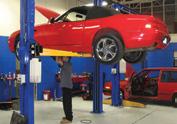

The new-car industry wasn’t dead or dying in New Zealand. In fact, it was very much alive and capable of returning reasonable profits for its shareholders.
That was the view of John Leighton, managing director of Mitsubishi Motors NZ, at the release of the new Pajero.
The company had posted a full-year profit for 1999 of $3.179m on gross sales of $323.98m. That was treble the profit of $1.06m on sales of $301.5m in 1998 and the results represented a 25 per cent return on shareholders’ funds.
Leighton said Mitsubishi was reasonable happy with its market share of 11.3 per cent and was planning to increase that percentage in 2000. He was particularly pleased with the marque’s strong sales of heavy trucks, achieving 28.5 per cent of all new trucks registered in New Zealand in 1999.
He added the company was delighted to have sold Todd Park for $13.5m. It was leasing part of the main building for its head office, plus a substantial area of the former assembly building for its parts operation.
Leighton said: “The company has also invested in computer technology utilising the internet to provide online communication with our national dealer network.”
March 23, 1998 Industry losing $45 million a month


Revenue from vehicle sales had plummeted nearly $46 million monthly since August 1997.

In the previous six months, registrations nationally had fallen from $493.6m to $447.9m for a decrease of more than nine per cent.
Sales in January were 12 per cent down compared to that month in 1997, with Auckland showing an even worse result – down 19 per cent.
In the previous six months, the country’s largest region for retail vehicles had seen registrations decline by $35.2m a month, from $202.6m to just $167.4m, according to Statistics NZ.
Sales in Wellington were down by $8m a month, while in the Waikato they had been holding their own.
However, registrations in the remainder of the North Island were up by $7.3m a month when compared with sales levels back in August 1997. Overall North Island sales were down $36.2m a month.
In the South Island, revenues in Canterbury were down just under $2m a month, while the remainder of the Mainland’s sales had dropped $7.7m for an overall decline of $9.5m.
March 9, 2007
Downward slide for imports
Statistics on vehicle sales for February 2007 painted a grim picture for the future of the car market for used imports.
Such first-time registrations reached 9,131 for the month. That was down by 6.8 per cent on January 2007’s 9,799 units and by 17.8 per cent on February 2006’s total of 11,107.
Figures just released by Land Transport NZ showed that monthly imports of used imports had dropped 30 per cent since February 2005, while year-to-date statistics showed they were down by 3,469 units between February 2006 and 2007.
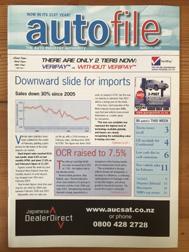


On the flipside, new-car sales were on the up with a 2.5 per cent increase in February. They climbed from 5,495 to 5,790. The total was down by 1,002 units on January’s 6,792, but the new-vehicle sector was optimistic 2007 would be strong for the trade.
Perry Kerr, chief executive of the MIA, said new vehicles had proved themselves as viable options for consumers.
“The new cars now represent the highest level of technology available globally and buyers are clearly recognising the outstanding value in buying vehicles new.”
18 www.autofile.co.nz looking back Don’t go searching for news. Let the news come to you. Subscribe now to for twice-weekly updates www.autofile.co.nz/subscribe INSIGHT
Clean-car policies impact value
Arecent decision by the Motor Vehicle Disputes Tribunal (MVDT) determined the value of a rejected vehicle to be its purchase price minus any subsidies the consumer received for it under the clean car discount (CCD).
It appears this was the first time that the clean-car programme has been confirmed to affect the value of a vehicle.
The decision creates a precedent that has interesting consequences, which are especially relevant with the destructive weather events of the past few months.
This case solidifies the understanding that the government’s clean-car policies affect the value of vehicles.
Specifically, the programme designed to promote the uptake of more efficient vehicles decreases the value of those models while increasing the value of less efficient vehicles.
In the short term, this dynamic does end up being a benefit to importers bringing in efficient vehicles because, if a vehicle is rejected, then the value of any subsidies through the CCD flow to traders.
That said, this would have the opposite effect for models that incur penalties. In this case, dealers would be responsible for paying back the price of the vehicle plus any CCD paid by the consumer.
This might sound like a good deal for the second-hand market in general since it is largely importing credit-earning vehicles.
It must be remembered,
however, that this programme must be getting in a hole that’s likely to be approaching $200 million and the government is looking at ways to redesign it so that it becomes cost-neutral.
We don’t yet know what the design will look like, but it is most likely to include more penalties and less credits.
In addition, we need to remember that targets for the clean-car programme will decrease over time, narrowing the range of credit or subsidy-earning models.
Insurance companies should be prepared for the idea that the “replacement value” will have to include price modifications from the clean-car programme.
includes the majority of the second-hand market, but it would hit pure electric vehicle (EV) dealers especially hard. Importers will not be able to trade those credits for their full value.
EV dealers will be forced to either trade those credits for a fraction of their value and lose the difference, or they will need to import high-emitting vehicles to utilise the full offset.
It’s an interesting outcome for a programme designed to promote the importation of electric cars.
In addition, finance companies need to consider how this will affect their businesses.
We’re already seeing that many dealers who sell penalty-earning vehicles are rolling those charges
Unfortunately, it’s more likely that subsidy recipients are spending their discounts on other things rather than using it to reduce their borrowing on cars.
It would be interesting to see what the effect of financing this “cash-back option” has on different segments of consumers. I suspect that the higher risk borrowers, also known as lower-income borrowers, end up getting much smaller benefits from their subsidies overall.
Tangentially related, importers need to be aware that they incur penalties or credits under the clean car standard when a vehicle is complied and not when it’s first sold in New Zealand.
Even if the car is never registered due to it being damaged, such as by flooding, the importer will still be responsible for paying any penalties for importing it.
Likewise, any credits earned will also remain. Consideration needs to be given as to whether insurers will expect the credits to be handed over or if the amount insured will exclude any credits earned.
Focusing again on the CCD, should insurers open their own clean-car programme “carbon accounts” so they can claim the credits for vehicles that have been written off, or do they simply deduct the value of any credits from their pay-outs?
While the last option seems to be the obvious and easiest choice, it would negatively impact importers focusing on more efficient vehicles, which currently

into sticker prices and helping buyers finance it, although this does bring up a discrepancy with the programme and how financing works.
With less efficient vehicles that receive penalties, buyers are financing the price of the car plus any penalties.
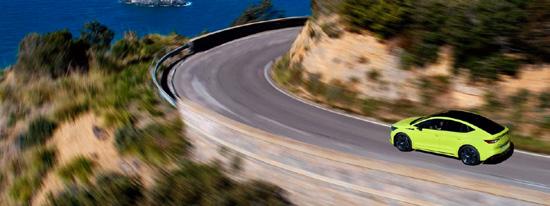
But with more efficient models, they are financing the entire price of the vehicle – not the price of the car minus the subsidy.
These concerns are more pressing than ever now with the inevitable increase in flooddamaged vehicles that are being dealt with due to recent weather events.
Between the fact our competitive supply dynamic has driven up the price of EVs and the realisation that the trading of credits will be a major ordeal, it seems the deeper one delves into how the clean-car policies work, the more one realises the real losers are importers specialising in EVs.
www.autofile.co.nz 19 tech report
KIT WILKERSON
Head of policy and strategy kit@via.org.nz
Advise • Advocate • Connect www.via.org.nz Imported Motor Vehicle Industry Association Advocate Advise Connect
It’s an interesting outcome for a programme designed to promote the importation of electric cars
Industry movers
BART TAYLOR has started in his role of head of automotive at Protecta Insurance following its takeover by Assurant.

He is responsible for developing goals and strategies to strengthen the business across various channels and networks.

Taylor joined the firm in 2019, and has held multiple general manager roles including for claims, operations and sales networks. Most recently he was GM of direct business and chief customer officer.
He has more than 30 years’ experience in insurance and banking. He previously worked for Allianz, Sovereign, BNZ and Westpac, and has lived and worked in Indonesia, Malaysia and Singapore.
ROWENA DAVENPORT has returned to MTF Finance to lead its credit function and offer strategic support to the wider business as part of its senior leadership team.
She took up the role in mid-February, initially for a 12-month period, and used to be chief executive officer of Otago law firm Gallaway Cook Allan and was also on the board of the NZ Rugby Union.

Davenport previously spent more than 16 years with MTF in treasury and strategy manager roles until June 2021. She has also worked for Dunedin City Holdings and Dunedin City Treasury.
DON ATKINSON has become UDC Finance’s chief executive officer having joined the company more than two decades ago.
He has taken over from Wayne Percival, who has stepped down after more than seven years. Percival is set join the company’s board as non-executive director from June.
Atkinson, pictured, was previously UDC’s chief operating officer. He has also been its head of lending, head of risk and dealers’ general manager.

DANE FISHER has become the Giltrap Group’s chief executive officer for retail and mobility, and continues to lead Sixt, its rental and subscription business. He takes over in his new position from Michael Giltrap.
Fisher, pictured, joined the company in 1997 as a part-time groomer and working in parts. His post-graduate roles included brand manager for Porsche and general manager of Audi NZ.

He spent two years with Lamborghini in Italy before joining Infiniti in 2014 where he was managing director of Asia and Oceania before becoming general manager of global business transformation and brand.
Fisher rejoined Giltrap’s as general manager of business development in 2019 and became Sixt’s chief executive two years later.
MICHAEL YANG has been appointed managing director of NZ Cheap Cars having formerly been national sales manager for 2 Cheap Cars.

The company’s first branch is operating from the former Moyes site in Mount Wellington, Auckland. Yang says there are plans to expand the operation nationally.
GM Specialty Vehicles (GMSV) has appointed Rochelle Nelson as its new national sales manager in New Zealand and Greg Rowe has been made the new director to oversee the business on both sides of the Tasman.

Nelson is responsible for the company’s sales operations at its seven New Zealand dealerships.
A third change of personnel sees Rob Omond step into Rowe’s previous role as general manager sales and operations for GMSV Australia and New Zealand.

It means Omond has taken charge of customer satisfaction, sales objectives and building relationships with the dealer network.
Marc Ebolo, managing director of GM Australia and New Zealand, says: “Greg, Rob and Rochelle have extensive experience in the automotive industry.
“Their appointments come at a pivotal time for GMSV with plenty of activity planned for 2023, including the introduction of the new model-year Chevrolet Silverado, as well as the launch of the first-ever Silverado ZR2 and Z06 Corvette.”
Nelson has replaced Matthew Taylor and Rowe has filled the position recently vacated by Joanne Stogiannis with both former members of staff moving to new opportunities outside of motoring.
Marque makes big changes at the top Funds inspiring futures
The first recipients of grants from the Inspiring Futures Foundation have been announced.
The organisation, which has assets of about $25 million, has been set up to support people working and studying in the automotive, transport and logistics, drilling, mining and quarrying, and gas sectors.
Its partners include the Motor Trade Association, Otago Polytechnic, the Collision Repair Association, Motor Industry Association and MITO.
Convenor Sturrock Saunders says: “It’s our aim to have the greatest impact to our stakeholder industries, learners and the learning environment.”
Successful first-round applicants include the Women in Automotive Collective.
Natasha Callister, one of its members, says: “Our funding will go towards developing a platform for women to access resources, be inspired by career stories of others and join a network of other women in the industry.
“It will also act as a resource hub for employers to support the recruitment and professional development of women.”
The Auto Super Shoppe Academy gets funding for a student-loan scheme, and to assist it apply for NZ Qualifications Authority accreditation and private training-enterprise status.
Perform-X Aotearoa has received a grant to implement a three-year project to help transport, automotive and freight employers access skilled staff over the long term.
20 www.autofile.co.nz news TO FEATURE IN INDUSTRY MOVERS EMAIL EDITOR@AUTOFILE.CO.NZ
Rochelle Nelson Greg Rowe Rob Omond
Be vigilant when assessing trades
Now is the time to take extra care when buying vehicles from the existing fleet or assessing trade-ins.
Flood damage can sometimes take quite a while to appear, but the consequences can be very significant – as in making the car next to worthless and being of scrap value at best.
Electrical corrosion might appear quickly, but body rust can take much longer. And remember once the car is in your care, then the monkey could still be on your back even after you have on-sold it.
I apologise if this sounds like a trip back to “selling 101”, but no harm done if it spikes your memory.
It’s easy to forget the basics and this might be the time to revisit good practice methodology. In this context, that starts with the in-depth scrutiny of buying and trade-in opportunities.
The geographic spread of potential flood impacts covers most of the North Island and the top of the South Island, and it’s a sure bet there will be owners trying to offload uninsured flooddamaged vehicles.


At a physical level, check the vehicle thoroughly and look for the expected tell-tale signs.
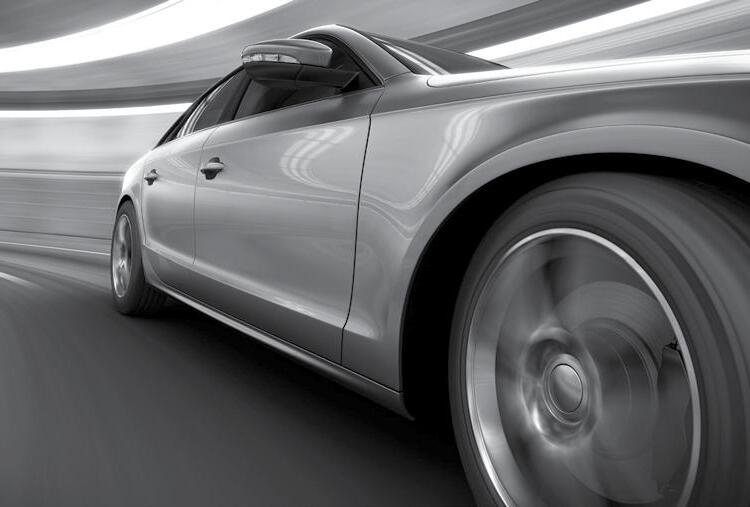
These include a musty smell, fogging of interior windows and lights, tidelines in difficult or lessvisible places, silt and flood debris
in nooks and crannies, and so on. Ideally, the car should go up on a hoist so you can get a good look.
On the flipside, it’s important to be alert to the opposite effects. These can include an older vehicle now being in immaculate condition as if it looks like it has just been through a substantial groom.
Paying close attention to the current owner’s address is required. Check to see if it’s a known flood location, while recent change of ownerships might be a warning signal – if recently purchased, why are they seeking to sell now? And, of course, be alert for the old “selling on behalf of my friend” type of situation.
Always ask relevant questions, notwithstanding that showing an interest in sellers and their vehicles helps to establish rapport. It’s worth remembering that the car is their baby and, if they’re genuine, they might have some good information to impart.
Check out the service history, if have they had any problems and what’s been done to the car while in their care.

And here’s the real “gotcha” question. “Is there anything you [the owner] know about this vehicle that I [the dealer] should know about?” Asking this forces the owner to either come clean or possibly withhold information.
In general, the Consumer Guarantees Act doesn’t typically apply to private transactions but the Fair Trading Act does, so even private sellers can’t hold back or provide misleading information.
Recourse may later rest on being able to dig up evidence, but if you’ve asked the right questions you start with “a foot in the door”, so to speak.
Be mindful of the seller’s body language, which might be served to contradict verbal answers.
Hesitation, a shifting stance, looking away and so on might be clues in themselves. Reading body language is an important part of every salesperson’s operating manual.
A set of pre-defined questions on a trade-in evaluation sheet could be a good strategy.
Notwithstanding this is good practice anyway, it also serves as a valuable record if needed later.
Remember a disputes tribunal often cites that a salesperson buys or sells lots of vehicles, but most consumers only purchase or sell one or two.
The customer is immediately ahead, so anything that helps balance the ledger will help you. His or her signature on the form would bring added credence, for example. Ultimately, a written summary and agreement shows clients their responses were being recorded.
That, in itself, might help bring some “honesty” to the occasion even if it doesn’t manifest in an outright mea culpa at the time, but perhaps later through rejection of your trade-in offer.
For future reference, Waka Kotahi maintains a damagedvehicle register in this section of its website – nzta.govt.nz/vehicles/ choosing-the-right-vehicle.
It tracks vehicles that have been written off by insurance companies. It’s a useful resource to check what you’re appraising doesn’t have history, such as being a write-off, bought at damaged auction, “fixed up” or rebirthed. Good practice should always be applied, but in these floods-ravaged times it carries extra relevance. Let’s be careful out there.
HELPING DRIVE YOUR BUSINESS The MTA brand is consistently associated with expertise, reliability and trust. Talk with us today about the benefits of MTA membership. mta.org.nz | 0800 00 11 44
TONY EVERETT Sector manager – dealers, Motor Trade Association
Be sure to check cars for flood damage
Powering up with heritage
The message from past company president Akio Toyoda to his engineers and designers was to “bring back a Corolla that captivates our customers”.
The result is the exclusively manual transmission GR hot hatch, built with the DNA of TOYOTA GAZOO Racing (TGR).
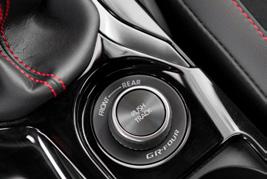

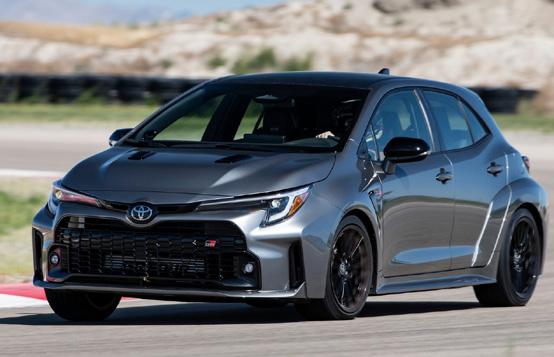
With 221kW of power and 370Nm of torque, the newest addition to the GR stable arrives here with a driveaway price of $74,990.
“While the model is mainly known as being reliable and dependable, the Corolla has a heritage of winning track and rally events,” says Steve Prangnell, general manager of Toyota NZ.

“By letting TGR’s engineers loose, we’ve produced that rare combination of a highperformance car that can be driven with confidence and enjoyment, as well as a daily drive with five seats, five doors and our complete safety sense package.”
The GR Corolla’s turbocharged 1.6-litre engine has 21kW more power than that in the GR Yaris. It’s paired with a five-speed intelligent transmission.
The all-wheel-drive system automatically distributes power from 50-50 split up to 30-70 front and rear for ultimate traction, and – by enhancing the drive with normal, sport and track modes –


this hot hatch is more than ready to rally.
While adopting the Corolla’s basic body framework so it inherits the high-speed stability of a long wheelbase, the GR employs wider track up-front and rear for a high level of cornering performance.
Prangnell says it’s exciting to see the TGR brand filtering into Toyota NZ’s line-up with the marque rolling out seven such models over the past few years.
“The GR Corolla shows how we can continue to offer a range of vehicles for all customer needs as we move Toyota’s overall model portfolio towards electrification,” he adds.
The car has an aggressive front grille, flared fenders to accommodate a wide track, rear diffuser, and functional vents to bolster aerodynamics and cooling.

The Kiwi model’s fit-out includes a carbon-fibre roof, vented hood and matte-black 18-inch wheels.

It also features Yokohama Advan Apex tyres, and front and rear Torsen limited-slip differential

for better grip while upgraded performance brakes help to dig into corners.
CROSSING THE LINE
Toyota has added a GR Sport model to the Yaris Cross’ line-up.

It boasts 18-inch, 10-spoke alloys with frosted white or ruby with an ink-painted roof available as two-tone exterior colours. There’s also a new mesh rearbumper garnish and front mesh grille with discreet GR badging.
The black interior features smoke-silver ornamentation, and GR-branded front sports seats and steering wheel.
The standard compact SUV has rewarding handling thanks to the GA-B platform – the same as that featured in the Yaris hatchback. This gives it a low centre of gravity, rigid body and balanced chassis.

In the GR Sport, which is priced from $43,290, performance has been sharpened with enhanced suspension for better steering, roll and grip feel.
It’s powered by a three-cylinder, 1.5-litre hybrid dynamic force engine. Its long stroke, high-speed combustion, high 14:1 compression ratio, and temperature and pressure controls help it to achieve a high thermal efficiency and low fuel consumption.

The 40-20-40 split-folding rear seat and a split-folding deck board allows load space to extend from 390 litres to a maximum of 1,097l.
As a high-grade model, the GR Sport has a rich standard-equipment specification, including dual-zone climate control with Nanoe X, head-up display, panoramic view monitor and rear privacy glass.
22 www.autofile.co.nz
To advertise here, contact: advertising@autofile.co.nz or ph 021 455 775 VEHICLES WANTED DEALERS BUYING NOW Automotive excellence since 1993. Your o cial Audi, Porsche, Jaguar, Land Rover and Volvo dealer Wellington 66 Cambridge Terrace, Te Aro, Wellington | 04 887 1306
new cars
Inside, a GR leather-trimmed steering wheel and unique gauge cluster remind the driver of the racing brand.
The GR Sport variant of the Yaris Cross
Toyota has let its engineers “loose” on the Corolla GR
Electric option for Chinese ute
JAC’s dual-cab T9
The JAC T9 ute will be launched in New Zealand later this year with a fully electric version to follow in 2024.
BLK Auto, a specialist importer and distributor, is introducing the dual-cab, four-wheel-drive (4WD) models here and across the Tasman.
A two-litre turbo-diesel version is slated for release in June with the electric variant due to arrive in the second quarter of next year.
New Zealand and Australia will be the first international export markets for the T9, which is currently only sold in China.
BLK Auto, which has bases in Queensland and NSW, is aiming to establish a home in Auckland and develop a “comprehensive dealer network” this side of the ditch.
It has had the JAC N55 electric truck in trials in both countries for the past two years and hopes the
ute’s launch will assist the business grow further.
Jason Pecotic, managing director, says the T9 will be priced similarly to rival Chinesemanufactured utilities, such as GWM’s Cannon and LDV’s T60.
He adds it will also be an attractive and more affordable alternative to top-selling models, such as Toyota’s Hilux and Ford’s Ranger.
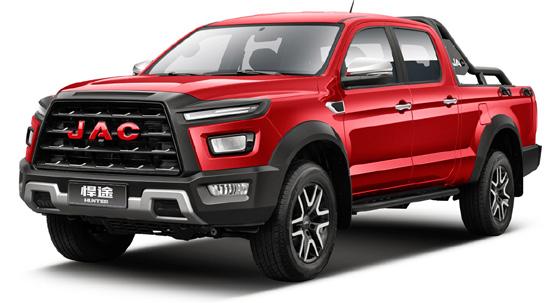



The T9 measures 5,330mm long, 1,965mm wide and 1,920mm high, while its wheelbase spans 3,110mm.
Impact on planet
The Polestar 2 has been updated to boost its green and efficiency credentials.

Thomas Ingenlath, the brand’s chief executive, says: “We have revisited materials and processes that go into making it, introducing updates that reduce climate impact and increase material traceability.
“These are important to how we improve cars over their lifetimes, not just with functionality and design updates but addressing sustainability and carbon footprint as well.”
Polestar’s partnership with Circulor, a UK-based software
company, now includes blockchain traceability of mica in addition to cobalt that’s already traced in its batteries so risk minerals can be traced from material source to finished product.
The tray carrying the battery casing will result in an emissions reduction of 750kg per units thanks to aluminium from smelters using renewable energy, while lowcarbon aluminium will be used in the wheels.
A 600kg/CO2 reduction per Polestar 2 will now be seen later this year as it total weight reduces by about 1,350kg.
The diesel version will produce 125kW of power with torque coming in at 410Nm. It has a 3,500kg braked towing rating, and an eight-speed ZF automatic transmission pairs with a part-time 4WD system.
On the inside is a 10.4-inch touchscreen entertainment system, electronically adjustable seats, cruise control and a 360-degree camera.
Safety features include seven airbags, a tyre-pressure monitoring system, hill-descent control,
lane-departure warning and lane-keeping assist, blind-spot detections, rear cross-traffic alert, forward collision warning and autonomous emergency braking.
The pricing and specification of the T9 will be announced closer to its launch, while details have yet to be released about the powertrain for the electric variant.
Pecotic says JAC’s ute range will complement the existing electric truck offering from the marque.
“Many buyers face a long wait to buy a pick-up, so we expect the T9 to be an extremely attractive alternative at a more affordable price-point,” he adds.
“By the end of 2023, we will be importing three models of JAC electric trucks. The two pick-ups will significantly add to the product range and help us grow our dealer network by giving our dealers more products to sell.”
www.autofile.co.nz 23
P. 0274 333 303 | E. pcurin@milesgroup.co.nz ooking to buy late model NZ NEW cars and commercials. Contact Paul Curin. VEHICLES WANTED P. 0274 333 303 | E. pcurin@milesgroup.co.nz Looking to buy late model NZ NEW cars and commercials. Contact Paul Curin. ANTED Toyota
P. 0274 333 303 | E. pcurin@milesgroup.co.nz H ilux • L and Cruiser • P rado Looking to buy late model NZ NEW cars and commercials. Contact Paul Curin. VEHICLES WANTED Hilux • Land Cruiser • RAV4 • Prado
SUVs & Utes
new cars
Leitch on the rise in GT3 racing
Brendon Leitch is “living the life” in sports-car racing after finishing fourth overall in the Asian Le Mans Series (ALMS) as a member of the German Leipert Motorsport team.
Together with team-mates Marco Mapelli and Gabriel Rindone, the Kiwi has forged his way to the front of the 2023 series after recovering from a poor first round to score third-place finishes in Abu Dhabi.
Leitch says the second round has made up for his first foray. “It’s a fantastic result. It’s definitely made the series for us after our mediocre result the weekend before in Dubai.”
The Southlander and Leipert Motorsport sit fourth overall in the GT3 category of this year’s ALMS after two top results in Abu Dhabi’s Yas Marina Circuit in late February.
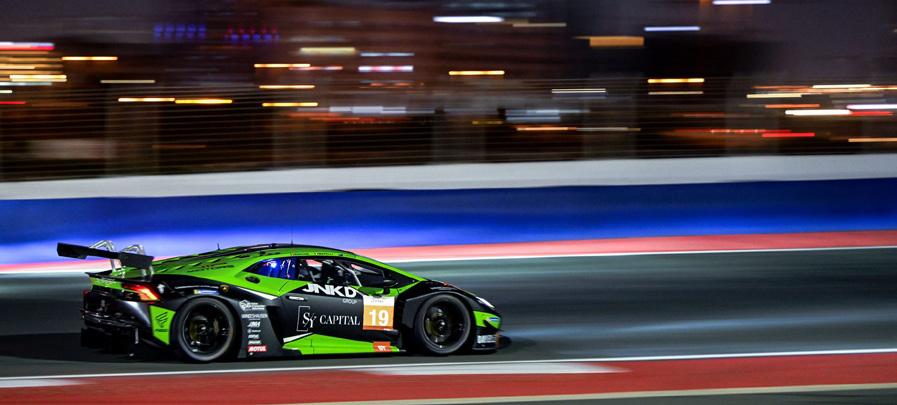
Driving a factory-supported Lamborghini Huracan GT3, Leitch finished third on the podium in the four-hour race.
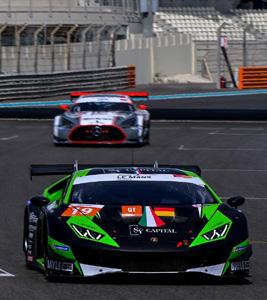
He then followed this up with another third place in the four-hour event after a post-race penalty for another team moved them up from fourth.
Leitch’s team took part in the opening two four-hour races in Dubai the week before. But they knew they had a competitive cardriver combination even though they came away with just one point,
He says: “We knew our line-up was strong but it just didn’t fall into place, whereas at Abu Dhabi
our strategy worked perfectly in the first race and the boys did an awesome job.”
The ALMS consists of four four-hour races over consecutive weekends in Dubai and Abu Dhabi attracting teams to compete in the LMP2, LMP3 and GT3 categories.
“We soon found out that our car wasn’t going to be the quickest even with its balance of performance being adjusted after the first race in Dubai,” says Leitch.
“What worked in our favour in the Saturday race is that we got the strategy almost bang on. The number of cautions and full-course yellows played into our hands, whereas in Sunday’s race there were very few for us to take advantage of.
“Gabbie [Gabriel Rindone] drove first and held 11th when I got into the car. I was able to soon get up to third as most other teams had amateur drivers in their cars, and Marco [Mapelli] was able to hold on for fourth at the end of the race.
“It’s been an awesome experience and we are really pleased with the end result. The support from Lamborghini, Leipert Motorsport, Dayle ITM and all our supporters has been fantastic. It was great way to get our GT season under way.”
Leitch is now back at his European base in Germany where he is testing the new Lamborghini Huracan GT3 EVO2, which he says
“will be a major step forward for us”.
Meanwhile, Leipert Motorsport has confirmed Leitch as one of four drivers to compete in the 2023 Le Mans Cup.


He will again pair up with Gerhard Watzinger to share the drive of the number-70 CrowdStrike Lamborghini GT3 EVO2 throughout the six-round competition.
Five of those rounds feature two-hour enduros run within the European Le Mans Series, while the highlight of the calendar is round three’s Road to Le Mans, which runs in support of the 24 Hours of Le Mans.
“Having a two-car team is really important in a series like this because we can co-develop set-ups at each round,” explains Leitch.
“Our driver pairings are competitive and we’re wellpositioned to fight for the title. Leipert was keen to run another car, but the series grid was already full.”
Leipert will announce a further GT3 programme as well as its Lamborghini Super Trofeo line-up shortly.

Leitch may also be called on for that role in the Trofeo having run double duties last year in that series and the GT World Challenge Europe Endurance Cup.
All in all, it makes for a busy year for the Kiwi, who has already competed in the New Zealand Grand Prix and Asian Le Mans Series. The Le Mans Cup gets under way in Barcelona on April 22.
24 www.autofile.co.nz motorsport
Leitch is back in Germany testing the new Lamborghini Huracan GT3 EVO2
The CrowdStrike-sponsored Huracan Leitch will compete with in the Le Mans Cup
Brendon Leitch in action at the Yas Marina Circuit in Abu Dhabi
It’s been an awesome experience and we’re pleased with the end result
Wurz secures series in style motorsport

Austrian Charlie Wurz stayed calm as drama unfolded around him to take the title in the final race of the 2023 Castrol Toyota Formula Regional Oceania Championship.

The series came down to the final round and final race at Taupo Motorsport Park.
Wurz had a troubled Saturday, but fought back the next day to win the championship.
The victory adds 18 FIA Super Licence points to Wurz’s tally as he continues his quest to follow father Alexander into a Formula 1 career.
On that final day, Wurz was third in the morning’s reverse-grid race to take the championship lead. He then took pole position for the last race and lead from start to finish in the Denny Hulme Trophy finale.
Callum Hedge, who had a threepoint lead in the title race on the
Sunday morning, could do nothing.
After the final race, Wurz was relieved and ecstatic. “I can’t feel any better,” he says.
“That race was the most difficult to win of this championship for me because it started raining a lot, I was so afraid of going off and I had to keep Laurens van Hoepen behind me.
Kiwis invade IndyCars
Scott Dixon first, then Scott McLaughlin and Marcus Armstrong, so who next? Possibly multiple New Zealand Grand Prix winner Nick Cassidy.
Armstrong and Cassidy are both products of our own Toyota Racing Series.
Chip Ganassi Racing (CGR), which runs Dixon and will have a part-season programme in place for Armstrong, has continued its driver-evaluation project by testing Cassidy at its final preseason session.
The 28-year-old joined CGR at the Sebring International
Raceway, Florida, where about two-thirds of the full-time field ran on the short outer loop.
“We’re excited to be able to test Nick, and owe a debt of gratitude to IndyCar and Nick’s team for making this happen,” says Mike Hull, CGR’s managing director.
“This is all in an effort to understand the driver landscape going into 2024 so we can be ready.”
Cassidy says it was a “big honour” to test for CGR. He is now in the third and final year of a Formula E race contract with Envision, and that means an Indy drive in 2024 is a definite possibility.
“Luckily, I got a bit of a gap and could relax a bit. Then the safety car came out and I thought ‘oh no’, so I had to get it all right in the restart but fortunately it was okay.
“This gives me a lot of confidence going into Europe.
“I know the competition is
REGIONAL OCEANIA FINAL STANDINGS
He says he wants to ensure his next deal is a long-term solution. “If I’m going to be here, I’m going to be committed.
“The Indy 500 is something that everyone should dream to win. It’s one of the biggest races in the world.”
Driving the sole Hondapowered car in action in the eightcar test, Cassidy completed a total
tough over there, but it has been strong here. I’ve learned a lot about racing in New Zealand.”
of 156 laps of the 2.74km short course, and finished the day 0.636 seconds off top spot but within 0.4 seconds of the second-placed car. He spent four seasons in Japan’s open-wheeler Super Formula Championship and took out the title in 2019.
A potential fifth IndyCars Kiwi, Hunter McElrea, is currently racing in the Indy Lights series.
www.autofile.co.nz 25
09 966 1779 www.jevic.com S P E C I A L I S T S I N PRE‑SHIPMENT INSPECTIONS MPI biosecurity inspections Biosecurity decontamination Heat treatment Odometer verifications Pre-export appraisals NZTA border inspections ? Lost documentation reports
Nick Cassidy testing an IndyCar run by Chip Ganassi Racing
1 Charlie Wurz (AUT) M2 Competition 343 points 2 Callum Hedge (NZL) M2 Competition 329 3 Jacob Abel (USA) Kiwi Motorsport 265 4 Liam Sceats (NZL) M2 Competition 245 5 James Penrose (NZL) Kiwi Motorsport 214 6 David Morales (USA) M2 Competition 200 7 Ryder Quinn (AUS) M2 Competition 199 8 Josh Mason (GBR) Kiwi Motorsport 186 9 Chloe Chambers (USA) Giles Motorsport 176 10 Ryan Shehan (USA) Giles Motorsport 173 11 Laurens van Hoepen (NED) M2 Competition 154 12 Louis Foster (GBR) Giles Motorsport 147 13 Tom McLennan (AUS) Kiwi Motorsport 117 14 Kaleb Ngatoa (NZL) Giles Motorsport 115 15 Lucas Fecury (BRA) Kiwi Motorsport 97 16 Bree Morris (NZL) Giles Motorsport 85 17 Adam Fitzgerald (IRL) Giles Motorsport 81 18 Brendon Leitch (NZL) Kiwi Motorsport 44 19 Billy Frazer (NZL) Hamilton Motorsport 33
Charlie Wurz was victorious in the final race at Taupo on February 12
Buyer uses wrong type of fuel in engine and tries to blame dealer for its failure
Background

Elizabeth Menzel bought a 2013 Volvo V60 Polestar for $12,999 from Trust Motors Ltd in May 2021.
Its engine had been replaced, but 10 months after purchase it experienced extensive damage. She wanted to reject the car and obtain a full refund.
The trader denied liability for what happened, saying it was caused by Menzel using the wrong fuel.
The case
The engine was replaced by Archibald & Shorter in January 2021. Its invoice showed the car misfired so it replaced the fuel injectors, but that didn’t fix the fault.
It then discovered water in cylinder number four, which had been damaged due to “pinking”, so it replaced the engine. Trust Motors was charged $7,376 for that work.
In May, Menzel inspected the Volvo at the dealer’s premises and was told the engine had been replaced, so “it was like having a new motor”. She was given a copy of Archibald & Shorter’s invoice.
But Menzel said the trader’s salesperson didn’t mention the previous damage had been caused by the wrong fuel being used in the car or advise her what grade should be used.
However, shortly after purchase, she downloaded and read a copy of the owner’s manual.
It stated: “Fuel of a lower quality than that recommended by Volvo must not be used as engine power and fuel consumption is negatively affected”. The document added that “most engines can be run with octane ratings of 95 and 98 RON. Only in exceptional cases should 91 RON be used”.
Menzel said that after reading the manual, she considered it appropriate to use 91 octane in her Volvo and did so throughout her ownership. She drove it without incident until March 16, 2022, when it broke down.
The Volvo was transported to
Endeavour Motors, which found the engine had no compression on number-four cylinder, possibly caused by impaired fuel-injector flow. It also found evidence of “random misfires”, and these also occurring in cylinders one, three and four. It recommended the engine be replaced.
Menzel contacted George Hiscock, Trust Motors’ managing director, who had the car assessed by Manukau Vehicle Servicing.
It also found the vehicle had low compression on cylinder four. It sent a fuel sample to Independent Petroleum Laboratory (IPL) for assessment. IPL’s report showed the Volvo’s fuel had an octane rating of 87.3, which was consistent with the rating of 91 octane fuel sold in New Zealand.
Manukau Vehicle Servicing reported the engine damage was caused by incorrect fuel use – using 91 octane would cause this due to “detonation” and “pre-ignition”.
However, Menzel didn’t accept the cause was her use of 91 octane. She had owned Volvos in the past and had used this fuel without problems.
She said Trust Motors should have told her the car’s previous engine had failed due to the wrong grade of fuel being used and that she shouldn’t use 91 octane.
The finding
The sole issue in this case was if the Volvo had been of acceptable quality for the purposes of the CGA’s section six.
The car suffered significant damage about 10 months after purchase and after Menzel had driven about 11,500km in it.
The question that the tribunal had to answer was whether this occurred because the Volvo was defective or lacked durability, or if it was caused by Menzel’s use of it.
Its use was relevant because the CGA’s section seven states goods don’t fail to comply with the guarantee of acceptable quality if used in a way inconsistent with the manner of use a reasonable consumer would expect to obtain from them.
The Volvo had a three-litre turbocharged V6 that with an engine-compression ratio that required using high-octane fuel, whereas 91 octane would cause detonation, or pinking, in the combustion chamber.
When pinking occurs, an uncontrolled explosion in the cylinder will inevitably lead to damage, including to the fuel injectors, piston and piston rings.
Menzel agreed she used 91 octane, but submitted it didn’t cause the issues with the engine. Instead, she considered it might have been caused by a faulty fuel injector in number-four cylinder.
The tribunal disagreed. It ruled the damage was caused by the wrong fuel being used.
As to Menzel’s submission her use of the car wasn’t unreasonable because she didn’t know she needed to use higher-octane fuel and Trust Motors should have told
The case: The buyer wanted to reject her Volvo V60 Polestar under the Consumer Guarantees Act (CGA) after its new engine seized. She said the trader should have told her to fuel the vehicle with high-octane petrol. The dealer denied liability for the damage because the owner’s manual specified the use of 95 and 98 octane.

The decision: The evidence showed the purchaser’s use of 91 octane petrol damaged the Volvo’s engine, so the case was dismissed.
At: The Motor Vehicle Disputes Tribunal, Auckland, via video link. her she needed to use that, the adjudicator said this argument failed for two reasons.
Firstly, Menzel ought reasonably to have known that high-octane fuel should have been used in the vehicle.
Shortly after purchase she downloaded and read the relevant sections of the owner’s manual. This clearly stated that 95 or 98 RON should be used, and that fuel of a lower octane than that recommended by Volvo “must not be used” and 91 octane should only be used in “exceptional cases”.
In the tribunal’s view, that information was more than enough to notify Menzel that higher-octane fuel should be used in her vehicle.
Secondly, the tribunal didn’t consider Trust Motors had an obligation to tell Menzel that high-octane fuel should be used in the Volvo. It stated it was the consumer’s responsibility to determine what type of fuel should be used in a vehicle.
Consequently, the tribunal was satisfied the Volvo had complied with the acceptable quality guarantee as laid down in the CGA because the engine damage was caused by Menzel using incorrect fuel.
By doing so, she had used the vehicle in a manner that was inconsistent with the manner of use a reasonable consumer would expect to obtain from the car.
The application was dismissed.
Order
disputes
A 2013 Volvo V60 Polestar
26 www.autofile.co.nz
disputes
Breach of contract sees trader keeping customer’s deposit to cover legal costs
Background

Zhanping Yang wanted to recover $3,104, which Ichinen Autos Ltd had retained after he cancelled an agreement to buy a 2016 Honda Fit in March 2022. He also wanted more than $10,000 in claimed losses and penalties.

Ichinen Autos said Yang had no grounds to cancel the VOSA, so it was entitled to retain the money and recover costs for breach of contract.
The case
Yang signed a VOSA on March 1 last year, and paid a deposit of $1,000 and $7,500 in cash. The rest the Fit’s $15,511 purchase price was to be funded by trading in his 2012 Toyota Prius.
When Yang went to collect the Honda, its windscreen was cracked and he considered it to be unsafe.
Ichinen Autos refused to replace it, so Yang cancelled the VOSA. He asked the trader to refund the $8,500 he paid to buy the Fit and wanted to retain ownership of the Prius.
The dealer said it was entitled to retain the $1,000 deposit under clause 6.3 in the VOSA, which stated the deposit was nonrefundable.
In a lawyer’s letter from Lee Salmon Long dated April 13, Ichinen Autos gave Yang options. These were complete the original purchase, or sell the Honda back for $7,500 with Yang keeping the Prius, which was, in effect, the trader retaining the deposit and returning other payments to Yang.
Lee Salmon Long also advised Yang he was breaching the VOSA and had to remedy that within two business days.
If he failed to do so, Ichinen Autos had the right to terminate the agreement and pursue remedies available to it, including repossessing the car without further notice and securing losses or costs arising from the default.
Yang replied he was entitled
to a full refund. On April 20, Lee Salmon Long wrote to him terminating the VOSA.
He was advised Ichinen Autos would uplift the Fit and refund the cash portion of the purchase price, minus the $1,000 deposit, $254 for registration fees and $1,850 in legal fees. The trader then refunded $5,396 to Yang.
At the hearing, Ichinen Autos advised its legal costs were only $1,590, so it had to return a further $260.
Yang told the hearing he wanted to recover the $3,104 retained by Ichinen Autos, and $3,104 as a remedy for the trader keeping money it wasn’t entitled to.
He also wanted $4,250 in compensation, which had been calculated at an interest rate of one per cent a day, for Ichinen Autos retaining the $8,500 for 50 days, $1,200 for hearing costs and $1,000 in punitive damages.
The finding
Firstly, the tribunal had to decide if the Fit was of acceptable quality under the Consumer Guarantees Act (CGA).
Waka Kotahi’s vehicle inspection requirements manual states a windscreen will fail a WOF inspection if its “critical vision area” is damaged “apart from scratching and surface pitting that does not affect the driver’s vision, such as small stone marks”.
Photos showed it had a stone chip and small cracks that weren’t in the critical vision area, so the vehicle had passed a WOF.
The damage didn’t make the windscreen unsafe, so the stone chip and small cracks were ruled to be minor wear and tear that a reasonable consumer would expect to find in a car of that price, age and mileage. This meant Yang wasn’t entitled to a remedy under the CGA.
Secondly, the tribunal found Yang wasn’t entitled to cancel the VOSA because he had no reasonable grounds to do so.
However, under section 36 of the Contract and Commercial Law Act (CCLA), Ichinen Autos was entitled to cancel the contract because Yang had rejected it.
Under the CCLA’s section 43, when a contract is rejected and cancelled, the tribunal can grant relief when it’s just and practicable to do so.
Ichinen Autos said it was entitled to retain $3,104. Yang claimed it should return that amount to him, with interest and compensation.
However, the adjudicator found the dealer was entitled to retain some of the purchase price paid by Yang because his rejection of the VOSA caused extra costs to the trader.
The tribunal disagreed the deposit forfeiture clause justified retaining the entire $1,000 in addition to other claimed costs and losses. That was because the clause had the potential to be a penalty.
Section 46 of the Fair Trading Act (FTA) states that a term that penalises one party, but not the other party, for a breach of the contract may be unfair.
The case: A Honda Fit’s windscreen was cracked so the buyer cancelled the vehicle offer and sale agreement (VOSA). The car had a warrant of fitness (WOF), so the trader said the customer had no grounds to do so. It kept $3,104 of the purchase price, but the consumer claimed the dealer couldn’t retain it.
The decision: The trader had the right to claim legal fees and on-road costs, but it was ordered to refund the buyer $1,260.
At: The Motor Vehicle Disputes Tribunal, Auckland.
In this case, the deposit forfeiture clause had the effect of penalising Yang for breaching the contract and there was no reciprocal clause under which the dealer was liable to a penalty for breach or termination of the VOSA.
The adjudicator said the FTA’s unfair contract-term provisions provided useful guidance in determining if Yang was entitled to relief under the CCLA.
It was found Ichinen Autos couldn’t rely on a forfeiture clause as justification for retaining the entire deposit as there was a real risk that clause was an unfair penalty.
Instead, the tribunal ruled the trader should only be entitled to recover reasonable costs and losses it had suffered due to Yang’s breach of contract.
Ichinen Autos had sold the Fit for $15,711, so it hadn’t suffered loss in that regard, but it had incurred legal costs arising from Yang’s breach and unwillingness to reach an amicable resolution.
Therefore, the tribunal found the trader was entitled to retain $254 for registration costs and $1,590 in legal fees.
The adjudicator didn’t consider it appropriate to make any award for costs and damages to Yang because he had breached the contract.
Order
Ichinen Autos had to pay $1,260 to the buyer.
www.autofile.co.nz 27
A 2016 Honda Fit




28 www.autofile.co.nz Phone 0800 ARMACUP (0800 276 2287) email Enquiries.NZ@armacup.com www.armacup.com Shipping to Driving the Pacific...
Total new cars
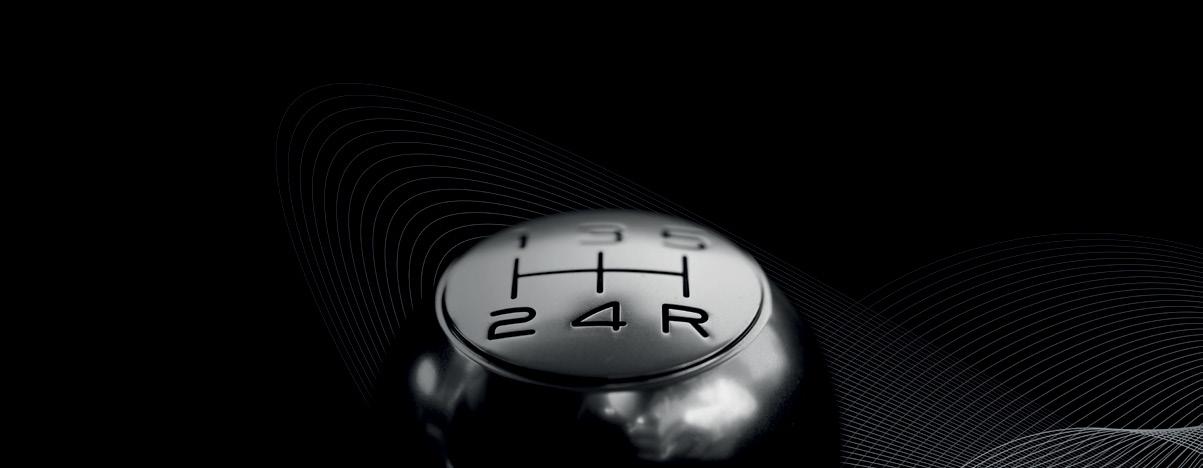
Total imported used cars

7,762

OTHERS (Chatham Islands, overseas, unknown) NORTHLAND NEW: 2022: USED: 2022: AUCKLAND NEW: 2022: USED: 2022: BAY OF PLENTY NEW: 2022: USED: 2022: GISBORNE NEW: 2022: USED: 2022: HAWKE ’S BAY NEW: 2022: USED: 2022: MANAWATU –WHANGANUI NEW: 2022: USED: 2022: WELLINGTON NEW: 2022: USED: 2022: MARLBOROUGH NEW: 2022: USED: 2022: CANTERBURY NEW: 2022: USED: 2022: OTAGO NEW: 2022: USED: 2022: SOUTHLAND WAIKATO NEW: 2022: USED: 2022: TARANAKI NEW: 2022: USED: 2022: NELSON NEW: 2022: USED: 2022: TASMAN NEW: 2022: USED: 2022: WEST COAST NEW: 2022: USED: 2022: 204 240 290 418 29.7% 42.6% 815 1,155 1,010 1,550 19.3% 25.5% 19 32 27 61 29.6% 47.5% 37 28 39 54 5.1% 48.1% 31 52 46 98 32.6% 46.9% 31 61 83 91 62.7% 33.0% 647 534 930 672 30.4% 20.5% 250 192 357 308 30.0% 37.7% 102 85 160 192 36.3% 55.7% 146 102 250 235 41.6% 56.6% 25 33 39 107 35.9% 69.2% 345 289 438 472 21.2% 38.8% 597 601 676 786 11.7% 23.5% 2,748 4,128 2,945 5,110 6.7% 19.2% 140 114 195 257 28.2% 55.6% Whangarei Auckland Hamilton Thames Tauranga Rotorua Gisborne Napier New Plymouth Wanganui Palmerston North Masterton Wellington Nelson Blenheim Greymouth Whangarei Auckland Hamilton Thames Tauranga Rotorua Gisborne Napier New Plymouth Wanganui Palmerston North Masterton Wellington Nelson Blenheim Greymouth Westport Christchurch Timaru Oamaru Dunedin Invercargill Whangarei Auckland Hamilton Thames Tauranga Rotorua Gisborne Napier New Plymouth Wanganui Palmerston North Masterton Wellington Nelson Blenheim Greymouth Whangarei Auckland Hamilton Thames A R OUND T H E COUNT R Y
Februar y 2023
2022: 10,718 27.6%
2022: 7,655 18.2%
6,259
FINANCE TO SHIFT Y OUR BUSINESS I N TO TOP GEAR Your Vehicle Import Finance Specialist To find out more visit us at www.blackbirdf і nance.co.nz or call us on 0800 000 999
Imported Passenger Vehicle Sales by Make - February 2023
Imported Passenger Vehicle Sales by Model - February 2023
WHAT DO YOU WANT FROM YOUR VEHICLE SUPPLIER?
30 www.autofile.co.nz
MAKE MODEL FEB '23 FEB '22 +/- % FEB 23 MKT SHARE 2023 YEAR TO DATE 2023 MKT SHARE Toyota Aqua 1,196 821 45.7 15.4% 2,288 15.4% Toyota Prius 697 377 84.9 9.0% 1,344 9.0% Mazda Axela 436 428 1.9 5.6% 870 5.8% Mazda Demio 268 157 70.7 3.5% 518 3.5% Toyota Corolla 254 185 37.3 3.3% 486 3.3% Honda Fit 239 235 1.7 3.1% 464 3.1% Nissan Note 230 116 98.3 3.0% 449 3.0% Volkswagen Golf 227 260 -12.7 2.9% 445 3.0% Subaru Impreza 201 241 -16.6 2.6% 384 2.6% Mazda CX-5 193 216 -10.6 2.5% 337 2.3% Nissan Serena 183 107 71.0 2.4% 342 2.3% Mitsubishi Outlander 166 284 -41.5 2.1% 336 2.3% Nissan Leaf 164 315 -47.9 2.1% 350 2.3% Suzuki Swift 159 128 24.2 2.0% 297 2.0% Nissan X-Trail 148 324 -54.3 1.9% 298 2.0% Toyota C-HR 148 61 142.6 1.9% 251 1.7% Subaru XV 118 79 49.4 1.5% 223 1.5% Toyota Vitz 109 59 84.7 1.4% 190 1.3% Toyota Sai 104 28 271.4 1.3% 208 1.4% Mazda Atenza 79 219 -63.9 1.0% 183 1.2% Mazda Premacy 76 116 -34.5 1.0% 168 1.1% Honda Vezel 70 39 79.5 0.9% 124 0.8% Volkswagen Polo 69 65 6.2 0.9% 131 0.9% Toyota Camry 68 47 44.7 0.9% 118 0.8% Nissan Juke 66 58 13.8 0.9% 116 0.8% Subaru Legacy 56 282 -80.1 0.7% 110 0.7% BMW 116i 54 79 -31.6 0.7% 92 0.6% Toyota Wish 49 87 -43.7 0.6% 87 0.6% Audi A3 48 73 -34.2 0.6% 98 0.7% Toyota Auris 48 50 -4.0 0.6% 83 0.6% BMW 320i 41 89 -53.9 0.5% 75 0.5% Honda Grace 40 20 100.0 0.5% 73 0.5% Nissan Lafesta 39 82 -52.4 0.5% 68 0.5% Honda CR-Z 36 25 44.0 0.5% 57 0.4% Honda Insight 36 22 63.6 0.5% 58 0.4% Others 1,647 4,944 -66.7 21.2% 3,179 21.3% Total 7,762 10,718 -27.6 100.0% 14,900 100.0%
MAKE FEB '23 FEB '22 +/- % FEB '23 MKT SHARE 2023 YEAR TO DATE 2023 MKT SHARE Toyota 3,009 2,976 1.1 38.8% 5,694 38.2% Mazda 1,114 1,337 -16.7 14.4% 2,198 14.8% Nissan 994 1,607 -38.1 12.8% 1,950 13.1% Honda 535 778 -31.2 6.9% 989 6.6% Subaru 462 959 -51.8 6.0% 899 6.0% Volkswagen 332 424 -21.7 4.3% 661 4.4% BMW 240 585 -59.0 3.1% 458 3.1% Mitsubishi 237 448 -47.1 3.1% 468 3.1% Suzuki 214 194 10.3 2.8% 407 2.7% Audi 175 333 -47.4 2.3% 337 2.3% Mercedes-Benz 131 262 -50.0 1.7% 239 1.6% Lexus 105 272 -61.4 1.4% 178 1.2% Ford 46 80 -42.5 0.6% 85 0.6% Volvo 18 69 -73.9 0.2% 37 0.2% Land Rover 14 49 -71.4 0.2% 25 0.2% Chevrolet 13 40 -67.5 0.2% 24 0.2% Dodge 13 23 -43.5 0.2% 16 0.1% Mini 12 37 -67.6 0.2% 29 0.2% Porsche 11 30 -63.3 0.1% 17 0.1% Jaguar 8 39 -79.5 0.1% 18 0.1% Jeep 8 32 -75.0 0.1% 12 0.1% Peugeot 8 10 -20.0 0.1% 15 0.1% Chrysler 6 22 -72.7 0.1% 12 0.1% Holden 6 28 -78.6 0.1% 14 0.1% BYD 5 0 500.0 0.1% 5 0.0% Hyundai 4 11 -63.6 0.1% 13 0.1% Bentley 3 5 -40.0 0.0% 19 0.1% Daihatsu 3 2 50.0 0.0% 4 0.0% Kia 3 2 50.0 0.0% 11 0.1% Smart 3 2 50.0 0.0% 7 0.0% Alfa Romeo 2 2 0.0 0.0% 5 0.0% Cadillac 2 2 0.0 0.0% 4 0.0% Citroen 2 6 -66.7 0.0% 3 0.0% MG 2 1 100.0 0.0% 4 0.0% Plymouth 2 2 0.0 0.0% 2 0.0% Others 20 49 -59.2 0.3% 41 0.3% Total 7,762 10,718 -27.6 100.0% 14,900 100.0%
Updated ratings affect feebates
The Imported Motor Vehicle Industry Association (VIA) is advising its members to check the updated safety ratings on the Rightcar website because the eligibility of some models for the clean car discount may have changed.
It says Waka Kotahi NZ Transport Agency has released the new information for 2023 along with details about crashavoidance features in used imports.

Storms hit sales
of actual spending in December and the lowest monthly total since April last year, when it clocked in at $190m.
There were 7,762 used-imported cars registered during February. That was a decrease of 27.6 per cent compared with 10,718 in the same month of last year. Toyota’s Aqua was the top-selling model on 1,196 units and its Prius was second with 697. Mazda’s Axela came third on 436. February’s top marque was Toyota with 3,009 registrations. Second spot went to Mazda with 1,114 and Nissan was third on 994.
Malcolm Yorston, VIA’s technical manager, says that to be eligible for a rebate under the feebate scheme, a vehicle must have a safety rating of three stars or more on the Rightcar website at the time of first registration.
“The updated safety ratings may affect the clean car discount for some vehicles,” he adds. “As an example based on 2022’s safety ratings, six model generations –including the 2005-11 Toyota Vitz and Yaris – are no longer eligible, but 10 others are now eligible.
“Check vehicles you intend to import using the dealer resources on Rightcar to ensure you aren’t caught out.”

The transport agency reviews safety ratings for all vehicles on an annual basis, normally in December, so they will change again for 2024. Email safevehicles@ nzta.govt.nz if you have queries about the ratings.
BRAKES ON MARKET
Spending on vehicles rose by just $1 million, or 0.7 per cent, in January compared with December when adjusted for seasonal effects.
Stats NZ reports this meant the amount spent on the industry using retail cards in that month totalled $203m. It was also down from the $208m recorded in the same month of 2022.
In actual terms, retail-card spending on vehicles came in at $195m in January for a year-on-year decline of $3m or 1.3 per cent.
The figure for the first month of 2023 was also down from $223m
Seasonally adjusted retail-card spending across all industries rose $171m, or 2.6 per cent, compared with December, according to Stats NZ.
For fuel, the total slipped by $14m, or 2.5 per cent, to $562m over the same period.
In actual terms, the total splashed out with cards on retail climbed $169m, or 2.7 per cent, in January compared with the same month in 2022.
FIRM MAKES FINALS
Avanti Finance is celebrating after scooping a gong in Australasia’s only annual debt market awards that are based on the votes of market participants.
The company has been named winner of the New Zealand securitisation deal of the year
category in the KangaNews Awards 2022 for its $250m residential mortgage-backed securities trust arranged by Westpac.
Avanti is one of New Zealand’s largest non-bank lenders by assets, loans and market share, and offers automotive, business, home and personal loans.
KangaNews, a one-stop information service on fixedincome markets both sides of the Tasman, recently announced the winners of the institutional and deal categories following polling of those involved in the debt markets.
Award-winners from New Zealand and Australia will be celebrated at a gala dinner in Sydney on March 21.
ON-JOB LEARNING
Thirty members of Turners’ national network have passed the company’s learning and development programme with “flying colours”. They took part in two courses at different levels held over 14 weeks.
Turners has been building a programme of internal training over the past few years as it looks to support its employees to learn and grow.
It has now taken this one step further with its pilot programme, which included external courses in business fundamentals and leadership.
“I’ve been impressed by what I have seen from the programme, particularly the commitment showed throughout,” says Greg Hedgepeth, chief executive officer of Turners’ automotive retail division.
www.autofile.co.nz 31 contact: Taka Arimoto email: arimoto@heiwa-auto.co.jp www.heiwa-auctions.com ü SOLID COMPANY ü QUALITY VEHICLES ü CHOICE & VARIETY OF STOCK ü EXPERIENCED AGENTS ü DEALER ONLY SUPPLIER ü GREAT VALUE FOR MONEY 0 5,000 10,000 15,000 20,000 25,000 Jan Feb Mar Apr May Jun Jul Aug Sep Oct Nov Dec 2019 2020 2021 2022 2023
Imported Passenger Registrations - 2019-2023
Used
Expansion of port ‘critical’
Port of Tauranga is hoping its planned expansion will not only ease the severe congestion it has been facing, but also help secure better outcomes for New Zealand’s supply chain.
Julia Hoare, who chairs the company, says backlogs over the past financial year have been exacerbated by berth capacity at its container terminal.
Planning and consultation for the port’s extension started in early 2019. However, it was unsuccessful in getting it included in the government’s shovel-ready scheme and for fast-track consenting.
The company is now finally
facing its much-delayed hearing in the Environment Court.
“It is frustrating after years of consultation and planning to be still on hold,” says Hoare. “Had we not had these delays, we would be finishing construction now.
“Our customers are facing the prospect of continued supply-chain disruption and deteriorating service levels with little relief in sight.
“New Zealand relies heavily on international shipping and it’s critical the country expedites further capacity as soon as possible. Tauranga is the best and easiest option to achieve this quickly.”
Port of Tauranga continued
to gain business from Ports of Auckland in 2021/22 with supplychain issues still biting.
Imports through Tauranga increased by three per cent to 9.7 million tonnes although exports dropped by 2.5 per cent to 15.9m tonnes.
Volumes through MetroPort – its inland container port in Auckland –jumped by 10.2 per cent, reflecting import cargo being diverted to the Bay of Plenty port to avoid delays through the country’s biggest city.
Tauranga recorded net profit of $111.3m in the past financial year, which was up by 8.7 per cent, and revenue of $375.3m –
USED IMPORTED PASSENGER VEHICLE ARRIVALS
up from $338.3m year on year. The improvement was off the back of total trade of 25.6m tonnes compared with 25.7m tonnes in 2020/21. Ship visits to Tauranga increased for the first time since 2018, up by 4.7 per cent to 1,369.
USED IMPORTS RISE
There were 7,538 used passenger vehicles imported last month. That was up by 44.7 per cent compared to 5,211 in January and up by 5.4 per cent on February 2022’s total of 7,149.
Japan accounted for 98.2 per cent of all used-car imports with 7,404 units.
Used Imported Passenger Vehicles By Country Of Export
32 www.autofile.co.nz Door-to-Door vehicle shipping experts ContaCt us today! To and from Japan, USa, UK, aUSTralia, Singapore, and The pacific Ph +64 9 303 0075 www.mmnz.biz www.mmnz.biz
20,000 19,000 18,000 17,000 16,000 15,000 14,000 13,000 12,000 11,000 10,000 9,000 8,000 7,000 6,000 4,000 JAN FEB MAR APR MAY JUN JUL AUG SEPT OCT NOV DEC 2014 2015 2017 2021 2018 2020 2019 2016 2013 2022 2023
COUNTRY OF EXPORT 2023 2022 2021 JAN ’23 FEB ’23 FEB MARKET SHARE % 2023 TOTAL Q1 Q2 Q3 Q4 2022 TOTAL MRKT SHARE 2021 TOTAL MRKT SHARE Australia 134 83 1.1% 217 723 639 559 432 2,353 2.6% 3,072 2.4% Great Britain 34 17 0.2% 51 160 160 69 123 512 0.6% 1,259 1.0% Japan 4,966 7,404 98.2% 12,370 20,718 27,387 19,322 20,313 87,740 95.6% 123,508 94.8% Singapore 23 3 0.0% 26 148 118 77 80 423 0.5% 1,378 1.1% USA 30 19 0.3% 49 139 122 99 127 487 0.5% 697 0.5% Other countries 24 12 0.2% 36 84 55 62 49 250 0.3% 403 0.3% Total 5,211 7,538 100.0% 12,749 21,972 28,481 20,188 21,124 91,765 100.0% 130,317 100.0%
Record level of loan defaults
The percentage of people falling behind on their car loans has hit its highest level since 2020.
Statistics published by Centrix show such arrears climbed to 5.3 per cent in December last year, and the credit bureau says this is a key indicator of the financial pressure many consumers and households are facing.
It’s the highest figure since the percentage of consumers behind on such repayments reached 6.2 per cent in June three years ago. About 12 months ago, it only came in at 3.8 per cent.
Keith McLaughlin, managing
director of Centrix, notes arrears were up across the board and more than 400,000 New Zealanders – or 11.3 per cent of the active credit population –were behind on their repayments in December.
He says: “A rise in vehicle arrears points to the challenges facing households as this is usually one of the last repayments people let slip.
“Additionally, Kiwi retailers are feeling the pinch as rising costs, employee turnover and overall reduced activity continue to bite at bottom lines.”
McLaughlin advises anyone
struggling to meet their obligations to get in touch with their credit provider as soon as possible.
The Centrix data shows the overall number of consumers in arrears on year-on-year debt payments was up by 10 per cent “as economic conditions continue to deteriorate”.
December’s figures were also the highest level recorded since February 2021 when they came in at 11.4 per cent.
Buy now, pay later and creditcard arrears have also climbed. For the last month of 2022, they stood at 9.2 and 4.5 per cent
respectively. Meanwhile, Centrix notes that consumer demand for automotive loans in January this year declined by 5.3 per cent when compared to the same month in 2022.


TRADER SALES UP
Dealers sold 14,360 second-hand passenger vehicles to public buyers during February.


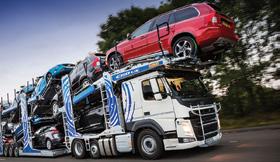
The total was up from 14,019, or by 2.5 per cent, compared to the same month of last year.
In addition, there were 11,187 trade-ins last month, which was a decrease of 7.6 per cent from 12,108 units.
www.autofile.co.nz 33
SECONDHAND CAR SALES - February 2023 DEALER TO PUBLIC PUBLIC TO PUBLIC PUBLIC TO DEALER REGION FEB '23 FEB 22 +/- % MARKET SHARE FEB '23 FEB '22 +/- % FEB '23 FEB '22 +/- % Northland 414 541 -23.5 2.88 1,486 2,000 -25.7 172 202 -14.9 Auckland 5,461 4,683 16.6 38.03 12,431 12,346 0.7 4,991 4,944 1.0 Waikato 1,322 1,421 -7.0 9.21 3,523 4,175 -15.6 1,018 1,160 -12.2 Bay of Plenty 915 1,002 -8.7 6.37 2,498 2,811 -11.1 550 613 -10.3 Gisborne 99 119 -16.8 0.69 254 338 -24.9 29 38 -23.7 Hawke’s Bay 486 556 -12.6 3.38 1,059 1,463 -27.6 253 388 -34.8 Taranaki 331 356 -7.0 2.31 935 1,050 -11.0 177 208 -14.9 Manawatu-Whanganui 733 822 -10.8 5.10 1,937 2,134 -9.2 628 749 -16.2 Wellington 1,300 1,325 -1.9 9.05 2,852 3,425 -16.7 894 1,044 -14.4 Tasman 124 124 0.0 0.86 412 483 -14.7 6 29 -79.3 Nelson 113 133 -15.0 0.79 416 460 -9.6 154 151 2.0 Marlborough 110 124 -11.3 0.77 372 398 -6.5 66 74 -10.8 West Coast 119 92 29.3 0.83 277 271 2.2 30 39 -23.1 Canterbury 1,912 1,732 10.4 13.31 4,809 5,198 -7.5 1,655 1,775 -6.8 Otago 611 630 -3.0 4.25 1,911 1,858 2.9 392 521 -24.8 Southland 261 292 -10.6 1.82 838 898 -6.7 172 171 0.6 Other 49 67 -26.9 0.34 144 151 -4.6 0 2 0.0 NZ Total 14,360 14,019 2.4 100.00 36,154 39,459 -8.4 11,187 12,108 -7.6
industry
Visit autofile.co.nz/jobs to view the latest jobs in the automotive
New Passenger Vehicle Sales by Make - February 2023
New Passenger Vehicle Sales by Model - February 2023
34 www.autofile.co.nz
MAKE FEB '23 FEB 22 +/- % FEB '23 MKT SHARE 2023 YEAR TO DATE 2023 MKT SHARE Suzuki 767 535 43.4 12.3% 1,342 8.6% Toyota 744 886 -16.0 11.9% 2,283 14.7% Hyundai 562 576 -2.4 9.0% 1,164 7.5% Mitsubishi 474 1,042 -54.5 7.6% 1,456 9.4% Kia 396 747 -47.0 6.3% 1,901 12.2% Honda 324 334 -3.0 5.2% 670 4.3% MG 314 442 -29.0 5.0% 738 4.8% Mazda 308 477 -35.4 4.9% 618 4.0% Ford 255 259 -1.5 4.1% 576 3.7% Volkswagen 197 186 5.9 3.1% 420 2.7% Subaru 191 237 -19.4 3.1% 485 3.1% Tesla 168 351 -52.1 2.7% 358 2.3% Skoda 159 130 22.3 2.5% 271 1.7% Haval 153 293 -47.8 2.4% 323 2.1% BYD 143 0 14,300.0 2.3% 378 2.4% Nissan 139 191 -27.2 2.2% 397 2.6% BMW 138 111 24.3 2.2% 294 1.9% Audi 121 106 14.2 1.9% 222 1.4% Land Rover 114 16 612.5 1.8% 239 1.5% Mercedes-Benz 97 107 -9.3 1.5% 256 1.6% Peugeot 82 16 412.5 1.3% 176 1.1% Porsche 55 81 -32.1 0.9% 116 0.7% Mini 49 55 -10.9 0.8% 112 0.7% Lexus 44 125 -64.8 0.7% 112 0.7% Cupra 36 13 176.9 0.6% 76 0.5% Volvo 34 50 -32.0 0.5% 85 0.5% Opel 31 0 3,100.0 0.5% 59 0.4% Renault 28 11 154.5 0.4% 45 0.3% Jeep 21 70 -70.0 0.3% 47 0.3% SsangYong 19 56 -66.1 0.3% 54 0.3% Jaguar 17 15 13.3 0.3% 43 0.3% Seat 14 5 180.0 0.2% 30 0.2% Citroen 11 3 266.7 0.2% 35 0.2% Isuzu 10 28 -64.3 0.2% 23 0.1% Alfa Romeo 8 5 60.0 0.1% 9 0.1% Fiat 7 4 75.0 0.1% 12 0.1% Aston Martin 6 1 500.0 0.1% 11 0.1% Polestar 6 33 -81.8 0.1% 16 0.1% Can-Am 3 7 -57.1 0.0% 6 0.0% Mahindra 3 3 0.0 0.0% 7 0.0% Chevrolet 2 4 -50.0 0.0% 11 0.1% Ferrari 2 5 -60.0 0.0% 8 0.1% Rolls-Royce 2 1 100.0 0.0% 4 0.0% Bentley 1 4 -75.0 0.0% 14 0.1% Others 4 34 -88.2 0.1% 18 0.1% Total 6,259 7,655 -18.2 100.0% 15,520 100.0%
MAKE MODEL FEB 23 FEB '22 +/- % FEB '23 MKT SHARE 2023 YEAR TO DATE 2023 MKT SHARE Suzuki Swift 487 289 68.5 7.8% 813 5.2% MG ZS 234 256 -8.6 3.7% 544 3.5% Hyundai Kona 217 253 -14.2 3.5% 384 2.5% Mitsubishi Eclipse Cross 215 281 -23.5 3.4% 636 4.1% Toyota RAV4 201 268 -25.0 3.2% 587 3.8% Mitsubishi Outlander 192 544 -64.7 3.1% 493 3.2% Honda Jazz 178 185 -3.8 2.8% 365 2.4% Mazda CX-5 155 128 21.1 2.5% 255 1.6% BYD Atto 3 143 0 14,300.0 2.3% 378 2.4% Hyundai Santa Fe 143 129 10.9 2.3% 237 1.5% Honda CR-V 114 86 32.6 1.8% 211 1.4% Toyota Highlander 112 57 96.5 1.8% 154 1.0% Ford Everest 111 146 -24.0 1.8% 223 1.4% Hyundai Tucson 106 78 35.9 1.7% 212 1.4% Toyota Corolla 103 137 -24.8 1.6% 320 2.1% Kia Sportage 97 138 -29.7 1.5% 298 1.9% Haval H6 96 169 -43.2 1.5% 197 1.3% Suzuki Ignis 96 47 104.3 1.5% 172 1.1% Tesla Model Y 95 0 9,500.0 1.5% 228 1.5% Toyota C-HR 90 43 109.3 1.4% 244 1.6% Suzuki Vitara 84 6 1,300.0 1.3% 132 0.9% Kia Stonic 82 237 -65.4 1.3% 423 2.7% Nissan X-Trail 77 156 -50.6 1.2% 203 1.3% Suzuki Jimny 73 107 -31.8 1.2% 169 1.1% Tesla Model 3 73 351 -79.2 1.2% 130 0.8% Toyota Yaris Cross 70 80 -12.5 1.1% 299 1.9% Kia Sorento 69 59 16.9 1.1% 177 1.1% Toyota Corolla Cross 67 0 6,700.0 1.1% 262 1.7% Subaru Outback 65 96 -32.3 1.0% 197 1.3% Kia Niro 60 68 -11.8 1.0% 398 2.6% Volkswagen T-Roc 59 58 1.7 0.9% 113 0.7% Haval Jolion 57 124 -54.0 0.9% 126 0.8% Subaru XV 57 61 -6.6 0.9% 125 0.8% Subaru Forester 53 71 -25.4 0.8% 120 0.8% MG 3 51 97 -47.4 0.8% 119 0.8% Volkswagen Tiguan 51 22 131.8 0.8% 95 0.6% Ford Escape 48 38 26.3 0.8% 145 0.9% Skoda Kodiaq 47 11 327.3 0.8% 90 0.6% Hyundai Ioniq 45 23 95.7 0.7% 67 0.4% Land Rover Defender 43 1 4,200.0 0.7% 105 0.7% Mazda Mazda3 39 74 -47.3 0.6% 92 0.6% Skoda Superb 39 52 -25.0 0.6% 46 0.3% Kia Niro Plus 36 0 3,600.0 0.6% 124 0.8% Ford Mustang 35 50 -30.0 0.6% 64 0.4% Land Rover Range Rover 33 2 1,550.0 0.5% 57 0.4% Others 1,661 2,577 -35.5 26.5% 4,691 30.2% Total 6,259 7,655 -18.2 100.0% 15,520 100.0%
new cars
Demand for petrol power falls
An analysis of statistics supplied to Autofile by the Motor Industry Association (MIA) illustrates just how much New Zealand’s automotive market changed in 2022.
Models with internal combustion engines (ICEs) only made up three-quarters of all new-vehicle sales in 2022 after sliding from an average of 86.4 per cent over the first three months of last year.

And the introduction of the government’s clean car discount at the start of April, which offers rebates on eligible low and zero-emissions vehicles, has spearheaded a shift in engine types sold to Kiwis.
Figures from the MIA show 75 per cent of registrations last year were for ICE vehicles, with a mix of electrified powertrains accounting for the other 25 per cent.
A breakdown of the numbers shows petrol-powered cars made up 49.2 per cent of new-vehicle sales in January 2022, but in the final five months of last year the percentage share of the market remained stuck in the 30s.
It meant the total for the year was 40.5 per cent, while diesel vehicles took out 34.5 per cent of the market in 2022.
Diesel sales retained a relatively stable percentage of registrations, except in March when they reached 53.2 per cent as people rushed to avoid penalties under the government’s clean-car legislation. They then sank to their lowest point – 15.6 per cent – the following month.
In contrast, non-ICE vehicles averaged just 13.6 per cent over the first three months of last year before finishing 2022 with nearly double that amount.
The market share for electric vehicles (EVs) peaked in the first month of the feebate scheme and hit 39.3 per cent in April.
Annual figures show battery electric vehicles (BEVs) accounted for 9.8 per cent of new-vehicle sales overall, plug-in hybrids
(PHEVs) took out 4.4 per cent and traditional hybrids 10.7 per cent.
BEVs recorded their strongest month in December with 19.4 per cent of the market, up from just 3.5 per cent in January.
April was the best month for PHEVs with an 11.4 per cent share of all vehicles sold, compared with January’s tally of just 1.5 per cent.
The highest point for hybrids also came in April when they took a 22 per cent market share, a sharp turnaround from 2.4 per cent the month before as buyers held off ahead of the full feebate scheme.
WHEN SIZE MATTERS
Sales of medium-sized SUVs dominated the newcar sector in 2022. They accounted for 34.2 per cent of light-vehicle registrations with 39,668 units – up from a market share of 26.9 per cent in 2021.
Next up were small SUVs with 33,326 registrations – down from 33.6 per cent to 28.7 per cent over the same timescale.
Large SUVs took out third spot with 11.4 per cent thanks to 13,213 units. Their market share dropped slightly from 12.5 per cent.
Light passenger vehicles came fourth with 11,553 sales to claim 10 per cent, which was up from
Suzuki gets double
8.6 per cent year on year. The top five was completed by small passenger vehicles. They dropped from 8.4 to 6.3 per cent with 7,316 registrations.
Looking at different segments of New Zealand’s market last year, registrations of all new passenger vehicles came in at 28,316. That was down from 28,539, or by 0.8 per cent, in 2021.
As for SUVs, overall they climbed by 5.5 per cent from 83,068 to 87,669 over the same period, according to the MIA. There were 40,948 new light commercials sold last year –down by 11.8 per cent from 46,404.
There were 6,259 new passenger vehicles sold last month. That was down by 18.2 per cent when compared to 7,655 in February 2022 and was the lowest monthly total since August 2021 when 4,609 were registered. The number-one model was Suzuki’s Swift on 487. The MG ZS was second on 234 followed by Hyundai’s Kona with 217. Last month’s top brand was Suzuki with 767 sales.
New Passenger Registrations - 2019-2023
Registrations of models in the pick-up/chassis cab 4x2 segment tumbled from 11,839 to 8,954, or by 24.4 per cent. Those in the 4x4 category fared better with a 1.9 per cent drop from 26,594 to 26,102.
Sales of new vans nosedived by 27.2 per cent from 7,601 in 2021 to 5,532 in 2022.
WHO BOUGHT WHAT
In 2022, there were 156,993 new light vehicles registered. That was down by 0.6 per cent when compared to 158,011 in 2021.
Of those, 63,632 went to private buyers – down by 12 per cent on the previous year.
Some 71,635 units were bought by businesses – up by 1.8 per cent, 5,459 were government purchases – up by 12.8 per cent and 16,207 were rentals for a jump of 54.9 per cent.
www.autofile.co.nz 35 new cars
0 1,000 2,000 3,000 4,000 5,000 6,000 7,000 8,000 9,000 10,000 11,000 12,000 Jan Feb Mar Apr May Jun Jul Aug Sep Oct Nov Dec 2019 2020 2021 2022 2023
Tesla’s Model Y was our top new EV in 2022
No obstacle for cutting emissions
Toyota NZ says it will still reach the company’s own targets for reducing carbon dioxide (CO2) emissions even if the Hilux remains as its best-seller.
Last year, the ute notched up 9,787 registrations. It was followed by the RAV4 on 5,683 units with the Corolla coming third.
And the first month of 2023 followed in a similar vein with 796 new Hiluxes being sold, and the Corolla and RAV4 completing the marque’s top three.
Neeraj Lala, chief executive officer, says: “Our goal has always been the depth and breadth of our range to ensure we’re meeting the needs of all customers.
“This includes commercials such as the Hilux, which meets the needs of a large sector of our base.
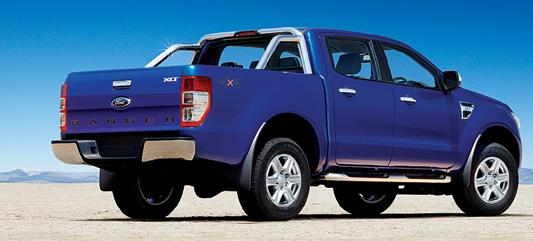


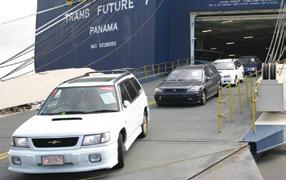

“We can still achieve number one for the Hilux while maintaining our reduction in CO2
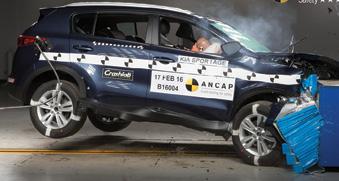
through our balanced portfolio. We will continue to do so throughout the year.”
Toyota NZ already committed itself to a 46 per cent reduction in overall CO2 emissions by 2030
New Commercial Sales - 2019-2023
when compared to 2019’s levels. General manager of new vehicles, Steve Prangnell, says that despite the Hilux being its bestseller, the company has maintained a reduction in emissions.
“This demonstrates the effectiveness of Toyota and Lexus having a balanced sales and product portfolio,” he adds.
“It’s also a testament to our commitment to reducing our CO2 impact while still providing high quality, reliable, affordable and safe vehicles.”
Toyota NZ notched up record sales in January with 49 per cent being hybrids. It was its bestever January for new-vehicle registrations since 2018 with
New Commercial Sales by Make - February 2023
New Commercial Sales by Model - February 2023
36 www.autofile.co.nz Know what’s going on in YOUR industry 0 1,000 2,000 3,000 4,000 5,000 6,000 7,000 8,000 9,000 10,000 Jan Feb Mar Apr May Jun Jul Aug Sep Oct Nov Dec 2019 2020 2021 2022 2023
MAKE FEB 23 FEB 22 +/- % FEB '23 MKT SHARE 2023 YEAR TO DATE 2023 MKT SHARE Toyota 944 1,076 -12.3 28.8% 1,933 29.8% Ford 932 1,139 -18.2 28.4% 1,823 28.1% Mitsubishi 233 882 -73.6 7.1% 549 8.5% Isuzu 212 302 -29.8 6.5% 378 5.8% LDV 132 224 -41.1 4.0% 233 3.6% Nissan 109 299 -63.5 3.3% 210 3.2% Fuso 105 98 7.1 3.2% 190 2.9% Mercedes-Benz 73 70 4.3 2.2% 113 1.7% Hino 65 90 -27.8 2.0% 123 1.9% Scania 53 20 165.0 1.6% 93 1.4% Volkswagen 53 58 -8.6 1.6% 109 1.7% Hyundai 52 65 -20.0 1.6% 92 1.4% Iveco 36 35 2.9 1.1% 64 1.0% Fiat 30 70 -57.1 0.9% 52 0.8% Volvo 30 11 172.7 0.9% 60 0.9% Mazda 26 99 -73.7 0.8% 47 0.7% Great Wall 24 77 -68.8 0.7% 46 0.7% Ram 22 27 -18.5 0.7% 47 0.7% DAF 21 13 61.5 0.6% 39 0.6% MAN 17 13 30.8 0.5% 36 0.6% Others 111 193 -42.5 3.4% 248 3.8% Total 3,280 4,861 -32.5 100.0% 6,485 100.0%
MAKE MODEL FEB '23 FEB '22 +/- % FEB 23 MKT SHARE 2023 YEAR TO DATE 2023 MKT SHARE Ford Ranger 859 1,109 -22.5 26.2% 1,654 25.5% Toyota Hilux 849 885 -4.1 25.9% 1,649 25.4% Mitsubishi Triton 230 854 -73.1 7.0% 541 8.3% Isuzu D-Max 117 237 -50.6 3.6% 212 3.3% Nissan Navara 109 299 -63.5 3.3% 210 3.2% Toyota Hiace 82 168 -51.2 2.5% 241 3.7% Ford Transit 73 30 143.3 2.2% 169 2.6% Isuzu F Series 51 20 155.0 1.6% 88 1.4% Mercedes-Benz Sprinter 50 63 -20.6 1.5% 75 1.2% LDV G10 46 79 -41.8 1.4% 82 1.3% Hyundai Staria Load 44 59 -25.4 1.3% 78 1.2% Isuzu N Series 35 32 9.4 1.1% 60 0.9% Fuso Canter 616 City 34 24 41.7 1.0% 56 0.9% Volkswagen Crafter 31 12 158.3 0.9% 59 0.9% Fiat Ducato 30 70 -57.1 0.9% 52 0.8% LDV T60 29 55 -47.3 0.9% 51 0.8% Iveco Daily 28 24 16.7 0.9% 49 0.8% LDV Deliver 9 28 43 -34.9 0.9% 44 0.7% Hino 500 26 52 -50.0 0.8% 50 0.8% Mazda BT-50 26 99 -73.7 0.8% 47 0.7% Others 503 647 -22.3 15.3% 1,018 15.7% Total 3,280 4,861 -32.5 100.0% 6,485 100.0% new commercials
overall CO2 emissions coming in at 169g/km – 11 per cent down from the same month in 2022.
Lala says that with January being such a big month, Toyota was able to make deliveries that have been delayed.
“We thank customers for their ongoing support as we start to regain stock allocation and deliver vehicles to those who have been waiting for a while,” he adds.
“We’re focusing on getting further allocation for the rest of the quarter to continue to meet demand and I’m incredibly proud to see our demand continues to swing towards electrified.”
He describes Toyota NZ’s 46 per cent reduction in CO2 emissions by 2030 as a “science-aligned emissions target”.
It includes the lifetime tailpipe emissions from all new and



used vehicles it sells annually, and is aligned with the UN Paris Agreement’s 1.5C pathway.
Lala adds it is New Zealand’s first automotive company to include lifecycle emissions from vehicles sold in its targets, which account for 86 per cent of the marque’s annual direct and indirect emissions.
And it needs to set ambitious goals as part of its response to climate change, contributing to the company’s aim of achieving net-zero carbon by 2050.
“Our greatest challenge is reaching our net-zero carbon goals while maintaining mobility for all,” he says.
“A 46 per cent emissions
Used Commercial Sales - 2019-2023
reduction by 2030 is a lofty target and represents a major step forward for Toyota NZ. There are challenges ahead for our business, but we’re also excited by the possibilities this presents to innovate.”
RANGER BACK ON TOP
There were 3,280 new commercials sold in February. That was down by 32.5 per cent compared to 4,861 during the same month in 2022.
The best-selling model was Ford’s Ranger on 859 units with the Hilux 10 sales behind. Third place was taken out by Mitsubishi’s Triton on 230.
As for used-imported commercials, there were 477 sold last month compared with 875 in February last year for a decrease of 45.5 per cent. The Toyota Hiace came first with 121 units.


Used Commercial Sales by Make - February 2023
Used Commercial Sales by Model - February 2023
www.autofile.co.nz 37
0 500 1,000 1,500 2,000 2,500 Jan Feb Mar Apr May Jun Jul Aug Sep Oct Nov Dec 2019 2020 2021 2022 2023
MAKE FEB '23 FEB '22 +/- % FEB '23 MKT SHARE 2023 YEAR TO DATE 2023 MKT SHARE Toyota 174 330 -47.3 36.5% 334 38.0% Nissan 108 244 -55.7 22.6% 213 24.3% Hino 36 76 -52.6 7.5% 59 6.7% Mitsubishi 33 35 -5.7 6.9% 57 6.5% Isuzu 32 67 -52.2 6.7% 57 6.5% Ford 27 29 -6.9 5.7% 43 4.9% Daihatsu 9 15 -40.0 1.9% 12 1.4% Mazda 8 9 -11.1 1.7% 13 1.5% Suzuki 5 7 -28.6 1.0% 8 0.9% Chevrolet 4 2 100.0 0.8% 8 0.9% Holden 4 16 -75.0 0.8% 12 1.4% Iveco 4 3 33.3 0.8% 7 0.8% Kenworth 4 4 0.0 0.8% 4 0.5% Dodge 3 3 0.0 0.6% 3 0.3% LDV 3 0 300.0 0.6% 4 0.5% UD Trucks 3 0 300.0 0.6% 5 0.6% DAF 2 2 0.0 0.4% 2 0.2% Fiat 2 3 -33.3 0.4% 8 0.9% Fuso 2 1 100.0 0.4% 3 0.3% GMC 2 3 -33.3 0.4% 3 0.3% Others 12 26 -53.8 2.5% 23 2.6% Total 477 875 -45.5 100.0% 878 100.0%
MAKE MODEL FEB 23 FEB '22 +/- % FEB '23 MKT SHARE 2023 YEAR TO DATE 2023 MKT SHARE Toyota Hiace 121 246 -50.8 25.4% 235 26.8% Nissan NV350 74 179 -58.7 15.5% 136 15.5% Hino Dutro 25 52 -51.9 5.2% 42 4.8% Isuzu Elf 22 45 -51.1 4.6% 38 4.3% Fuso Canter 21 20 5.0 4.4% 33 3.8% Toyota Regius 19 15 26.7 4.0% 39 4.4% Toyota Dyna 14 36 -61.1 2.9% 25 2.8% Ford Ranger 13 13 0.0 2.7% 20 2.3% Nissan Caravan 13 35 -62.9 2.7% 30 3.4% Toyota Toyoace 11 19 -42.1 2.3% 19 2.2% Daihatsu Hijet 9 14 -35.7 1.9% 12 1.4% Hino Ranger 9 22 -59.1 1.9% 13 1.5% Ford Falcon 7 1 600.0 1.5% 10 1.1% Isuzu Forward 7 16 -56.3 1.5% 13 1.5% Nissan NV200 6 3 100.0 1.3% 16 1.8% Nissan Atlas 5 15 -66.7 1.0% 14 1.6% Suzuki Carry 5 6 -16.7 1.0% 8 0.9% Toyota Hilux 5 8 -37.5 1.0% 12 1.4% Nissan Civilian 4 4 0.0 0.8% 7 0.8% Nissan Navara 4 1 300.0 0.8% 5 0.6% Others 83 125 -33.6 17.4% 151 17.2% Total 477 875 -45.5 100.0% 878 100.0% Subscribe now at www.autofile.co.nz/subscribe INSIGHT Keep up to date with the latest automotive news used commercials t
Tax breaks for greener cars
The Japanese government is proposing an extension to tax breaks for lowemissions vehicles past the end of 2023 while increasing the required level of emissions reductions for eligible models in several stages from next year.
The tax-code revisions are being slated to remain in place until April 2026 and will cover half of all domestically built new passenger vehicles.
The government is also aiming to exclude petrol-powered cars in 2025 from taxation cuts that have been awarded to Japan’s automotive industry to help it overcome supply constraints.
Key changes under the revised code, which have been timetabled to kick in during the next fiscal year that starts in April, have yet to be voted on by parliament.
Japan’s ruling coalition is finalising the tightening of rules for greener cars’ tax breaks to try to accelerate the shift to electric models.
Reductions in vehicle weight tax are currently offered on passenger vehicles that at least partially meet the government’s fuel-economy standard.
The current rules mandate that marques’ new vehicles must reach 25.4km/l by 2030.

Under the proposals, standards will be tightened from January 2024 with a 50 per cent tax reduction on models hitting at least 80 per cent of the target and a 25 per cent cut for those making it to at least 70 per cent.
The rules will again be adjusted by May 2025 with a 50 per cent tax reduction for those that reach 90 per cent of the target and
Dealer stock of new cars in New Zealand
one-quarter coming off for those achieving 80 per cent.
Japan has already been aiming for all new vehicles manufactured there to be at least partially electric by 2035. At the moment, 70 per cent of new vehicles sold in the country qualify for eco-car tax breaks. Under the new rules, only half would qualify for them.
Meanwhile, the Japanese government is downgrading its classification of coronavirus. This will bring an end to quarantine guidelines for patients, and a review of border controls and mask recommendations.
Exactly how the country will transition to post-pandemic normality remains uncertain as it continues to see high numbers of deaths daily from coronavirus and hospitals packed with patients amid an eighth wave of infections.
Daily sales fall
Imports of new cars in February came in at 6,912. This was down by 18.8 per cent from the same month a year earlier, but 10.4 per cent above January’s total of 6,259 units.
Registrations of 6,259 new passenger vehicles were completed last month, which was down 18.2 per cent from February 2022. It also represented a fall of 32.4 per cent from 9,261 units in January.
The numbers have resulted in the stock of new cars still to be registered increasing by 653 to 81,896. Daily sales, as averaged over the previous 12 months, stand at 316 units per day – up from 302 a year earlier.
February’s results mean stock athand has increased to 259 days, or 8.5 months, if sales continue at the current rate. In the same month of 2022, stock at-hand stood at 276 days.
38 www.autofile.co.nz
CAR SALES VARIANCE STOCK DAILY SALES - 12-MONTH AVERAGE DAYS STOCK AT HAND IMPORTED REGISTERED Feb ‘22 8,517 7,655 862 83,245 302 276 Mar ‘22 10,322 11,200 -878 82,367 305 270 Apr ‘22 8,555 8,521 34 82,401 304 271 May ‘22 8,488 10,554 -2,066 80,335 306 263 Jun ‘22 9,439 9,538 -99 80,236 304 264 Jul ‘22 9,368 8,036 1,332 81,568 298 273 Aug ‘22 9,928 10,925 -997 80,571 316 255 Sep ‘22 11,219 10,589 630 81,201 312 260 Oct ‘22 12,011 10,743 1,268 82,469 316 261 Nov ‘22 11,493 11,161 332 82,801 316 262 Dec ‘22 9,936 8,492 1,444 84,245 319 264 Jan ‘23 6,259 9,261 -3,002 81,243 320 254 Feb ‘23 6,912 6,259 653 81,896 316 259 Year to date 13,171 15,520 Change on last month 10.4% -32.4% 0.8% Change on Feb 2022 -18.8% -18.2% -1.6% LESS IMPORTED LESS SOLD LESS STOCK DAYS STOCK IN NZ - NEW CARS 340 320 300 280 260 240 220 200 180 0 FEB MAR APR MAY JUN JUL AUG SEP OCT NOV DEC JAN FEB Days of stock
Fast. Reliable. What more would you need?
February 2022 — February 2023 February 2021 — February 2022
Automotive industry needs support
The Motor Trade Association (MTA) is urging Prime Minister Chris Hipkins to prioritise the automotive sector in the run-up to October’s election.
Brian Anderton, advocacy and stakeholder manager, says: “Our industry is literally what keeps the country moving. There are a number of issues affecting it that can’t wait until a new government is sworn in at the end of the year.
“In signalling a reprioritisation of policies, the prime minister has already stated his government will be focused on small businesses that are finding it tough going. That includes many in our sector.”
The MTA is lobbying for more automotive professions to be added to the immigration system’s green list to alleviate the labour shortage affecting many firms.
It adds that unless action is
taken, the government runs the risk of its emissions reduction and roadsafety targets being impacted.
In December, skilled motor mechanics were added to the green list, but there’s still a shortage of panel-beaters and vehicle painters.
“Coupled with the high cost of living, many businesses are doing it tough,” says Anderton. “If repairers and panel-beaters are short-staffed or closed, it can mean more unsafe vehicles on the road as repairs and maintenance are deferred.”
While changing immigration settings will provide a short-term fix to the labour shortage, the MTA also wants Hipkins and his ministers to support young people in the automotive sector as a longterm solution.
It says one way to do so is to extend Apprenticeship Boost,
which pays firms $500 a month for each apprentice for two years.
Last year, as Minister of Education, Hipkins sang the scheme’s praises as the 50,000th apprentice passed through it.
“A locally trained workforce provides for greater economic security,” he said. “It delivers a highly skilled workforce to build infrastructure or design technology needed to future-proof the economy while ensuring good jobs for New Zealanders.”
The MTA wants Hipkins to back that up by extending Apprenticeship Boost past its December expiry date.
And, when Minister of Police, he described the number of ram-raids as “unacceptable” and pledged to help businesses stay safe. Anderton says: “Now he’s in the top job, we urge him not to lose this focus.”
Imports climb
There were 7,538 used cars imported last month, a jump of 44.7 per cent from January when only 5,211 units crossed our borders. February’s figure was also up 5.4 per cent from the same month a year earlier.
A total of 7,762 units were registered last month. This was 8.7 per cent more than 7,138 during January this year, but a decrease of 27.6 per cent from the 10,718 sales in February 2022.
With 224 fewer used cars imported than registered last month, it brought unregistered stock on dealers’ yards, or in compliance shops, to 11,829 units. This was 55 per cent below the total of 26,299 a year ago.
Average daily registrations dropped to 287 – down from 340 a year ago – and there is 41 days’ stock remaining.
Dealer stock of used cars in New Zealand
We pride ourselves on speed of delivery
Our aim is to ensure we ship your vehicles as fast as we can cutting out unnecessary and costly delays. With spaces available on next vessel direct sailings from Japan to New Zealand our speed of delivery won’t slow your business down.
www.autofile.co.nz 39
CAR SALES VARIANCE STOCK DAILY SALES - 12-MONTH AVERAGE DAYS STOCK AT HAND IMPORTED REGISTERED Feb ‘22 7,149 10,718 -3,569 26,299 340 77 Mar ‘22 7,890 24,338 -16,448 9,851 377 26 Apr ‘22 7,999 6,497 1,502 11,353 367 31 May ‘22 11,833 6,876 4,957 16,310 355 46 Jun ‘22 8,649 7,403 1,246 17,556 344 51 Jul ‘22 6,498 8,233 -1,735 15,821 331 48 Aug ‘22 8,594 7,935 659 16,480 333 49 Sep ‘22 5,096 7,366 -2,270 14,210 333 43 Oct ‘22 5,064 7,235 -2,171 12,039 324 37 Nov ‘22 6,297 7,151 -854 11,185 312 36 Dec ‘22 9,781 6,986 2,795 13,980 304 46 Jan ‘23 5,211 7,138 -1,927 12,053 296 41 Feb ‘23 7,538 7,762 -224 11,829 287 41 Year to date 12,749 14,900 Change on last month 44.7% 8.7% -1.9% Change on Feb 2022 5.4% -27.6% -55.0% MORE IMPORTED LESS SOLD LESS STOCK DAYS STOCK IN NZ - USED CARS 180 160 140 120 100 80 60 40 20 FEB MAR APR MAY JUN JUL AUG SEP OCT NOV DEC JAN FEB Days of stock www.moana-blue.com 0800 MOANA BLUE (0800 662 622)
February 2022 — February 2023 February 2021 — February 2022
LET AUTOHUB HELP YOU WITH SHIPPING SOLUTIONS TO GET YOU BACK ON SOLID GROUND

www.autohub.co +64 9 411 7425 info@autohub.co.nz
GLOBAL VEHICLE LOGISTICS NZ - JAPAN - AUSTRALIA - UK - SINGAPORE
YOUR IMPORT
TIGHT ROPE?
FEELING LIKE
CAR SALES BUSINESS IS WALKING A































































































































